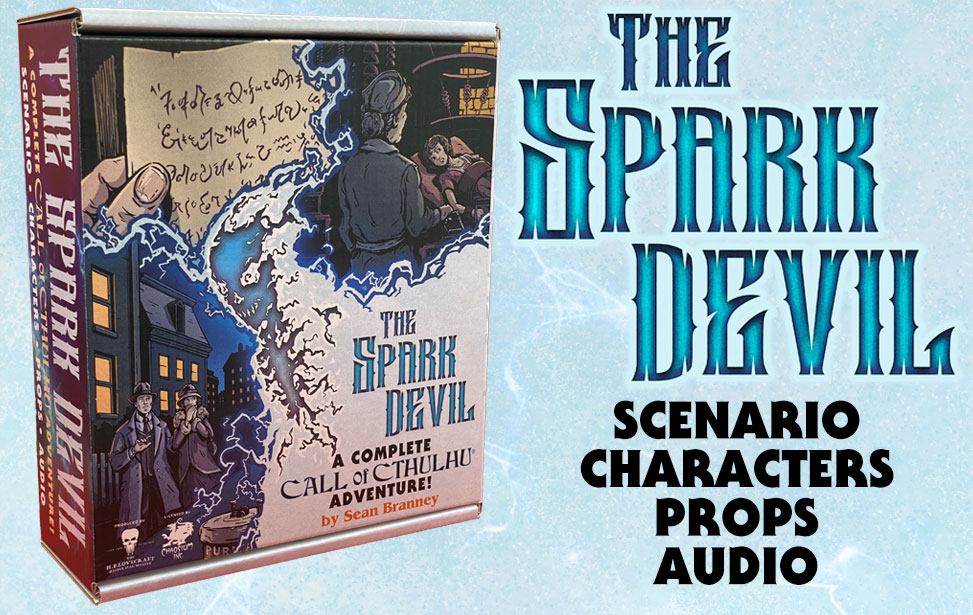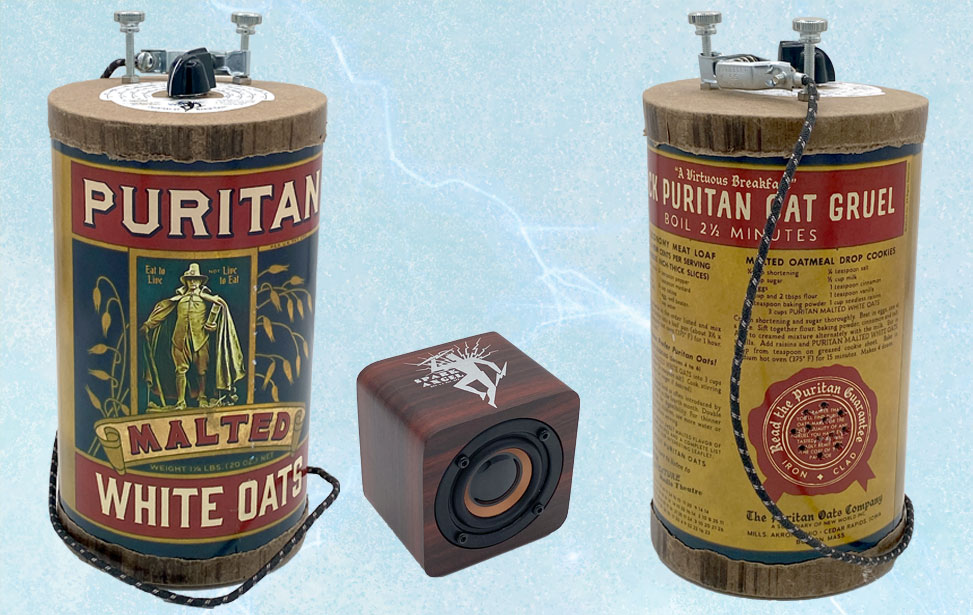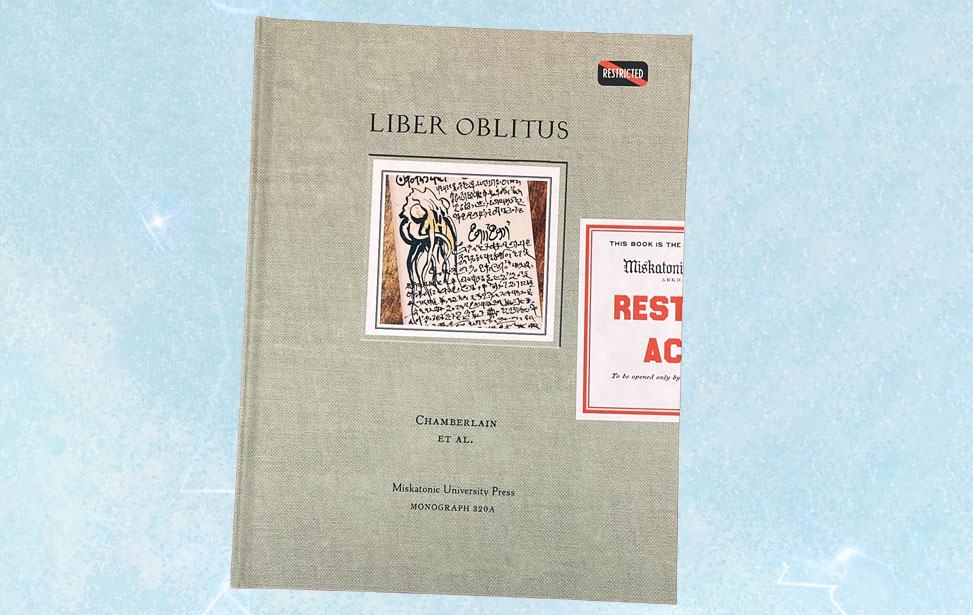The Spark Devil
This adventure is an original scenario written by the HPLHS' Sean Branney with a fantastic set of props created by Andrew Leman. The adventure makes extensive use of real Providence history and locations to create the most authentic setting possible. Investigators can explore Lovecraft's home town as they strive to stave off an entirely new Mythos threat. Both newcomers to Call of Cthulhu® and seasoned veterans will find this story an engaging mystery filled with perilous surprises. The deluxe box set measures 13.5 x 11.75 x 4.5 inches and weighs almost 5 pounds, containing everything you need to play. While the game is designed to be played in-person around the table, we are also providing digital versions of most of the props so you can play remotely/online!
In addition to cinema-quality physical props, the adventure comes with a collection of professionally-produced audio props. These downloadable MP3 files can be played through the prop radio (and/or any other playback device of your choice) to bring you interactions with NPCs and mysterious radio broadcasts integral to the story.
Contents
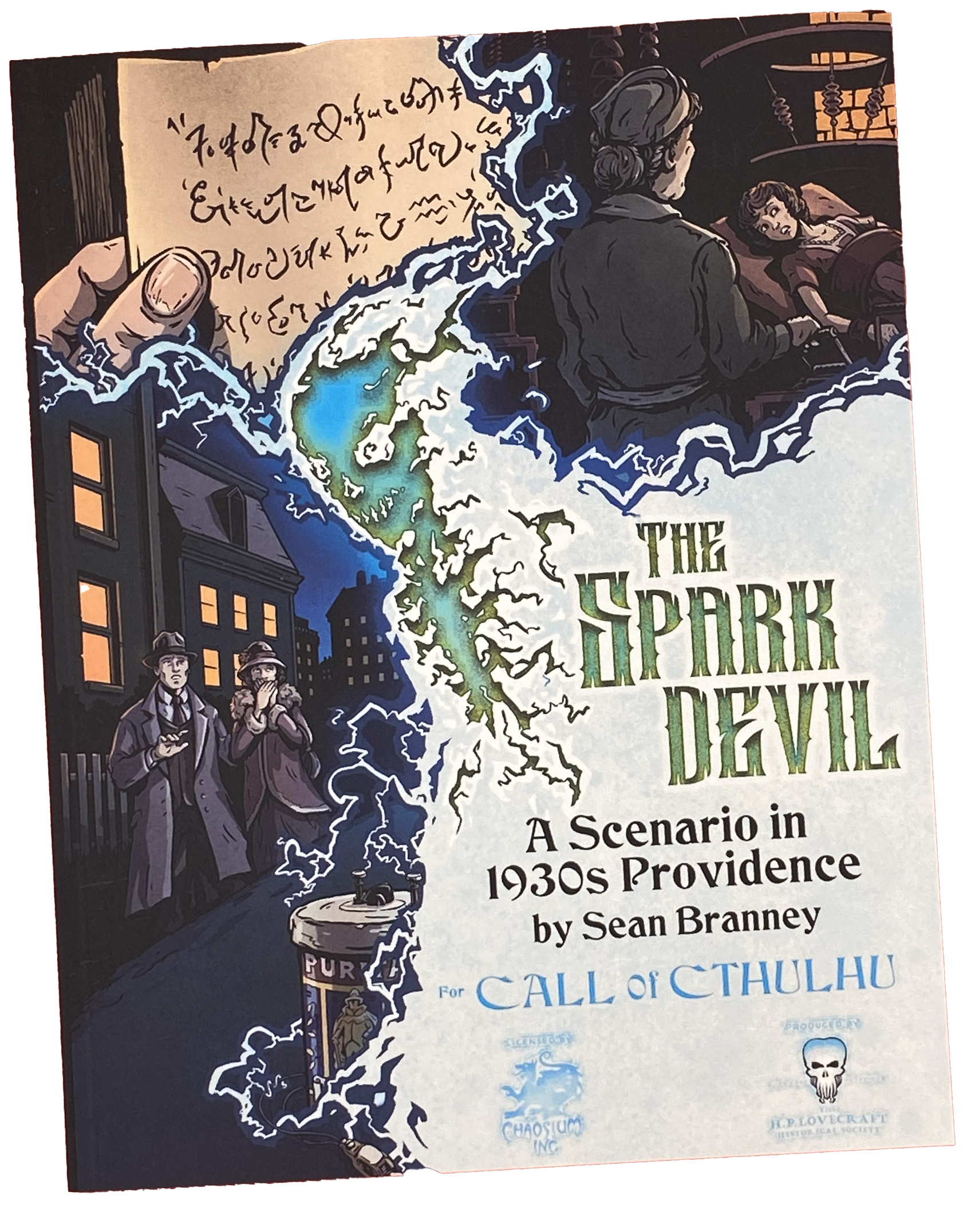 The scenario itself is presented in an 86-page perfect-bound book with cover art and interior illustrations by Ukrainian artist Vladyslav Yurasov. The book is further illustrated with map details, images of all the props, historical photographs and more, including a number of sidebars to give Keepers even more resources for running the game.
The scenario itself is presented in an 86-page perfect-bound book with cover art and interior illustrations by Ukrainian artist Vladyslav Yurasov. The book is further illustrated with map details, images of all the props, historical photographs and more, including a number of sidebars to give Keepers even more resources for running the game.
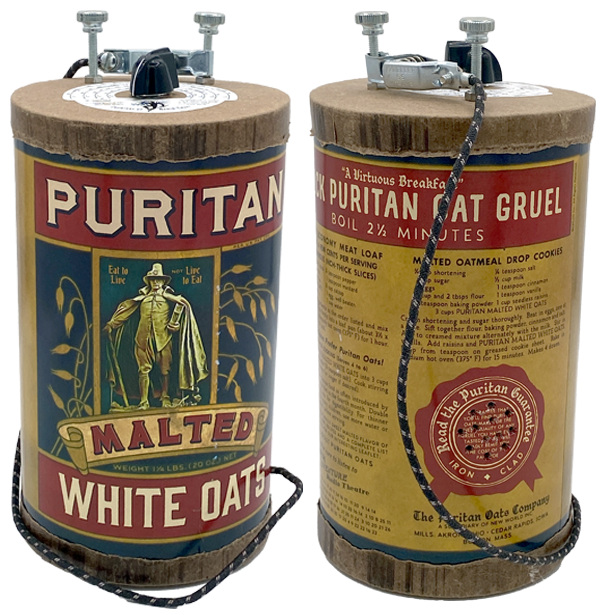 One of the key props in this game is a homemade radio built out of an oatmeal canister.
One of the key props in this game is a homemade radio built out of an oatmeal canister.
The prop is inspired by real vintage radios that were built by hobbyists in the early 1920s. When the Quaker Oats Company first introduced its now-iconic cylinder packaging in 1915, early amateur radio enthusiasts discovered that its size and shape made a handy armature for winding antenna coils. Quaker took advantage of the situation starting in 1921 by offering a free crystal radio set as a promotion to people who sent in proofs of purchase and a dollar. Although the official promotion only lasted a couple of years, the oatmeal canister radio remained a fascinating bit of early radio history.
Our prop replica is a fictionalized version of the original article. It has a tuning knob on top and some metal posts meant to simulate the look of vintage radio components, as well as a cloth-covered wire coming out of the bottom with a very substantial alligator clip which you can attach to any handy metal object to improve "reception". These components are all for the sake of appearance: they don't really do anything technical. (The recipes on the label are, however, fully functional.) The cardboard canister itself does act as something of a resonating chamber to give an authentic old-radio sound to the audio played through the prop. TIP: We have found that if you lift the lid of the canister even slightly, it increases the volume quite perceptibly while retaining the old-time radio vibe.
We have installed the knob, posts and wire to be replaceable by ambitious Keepers who wish to make their radios even more technically complex.
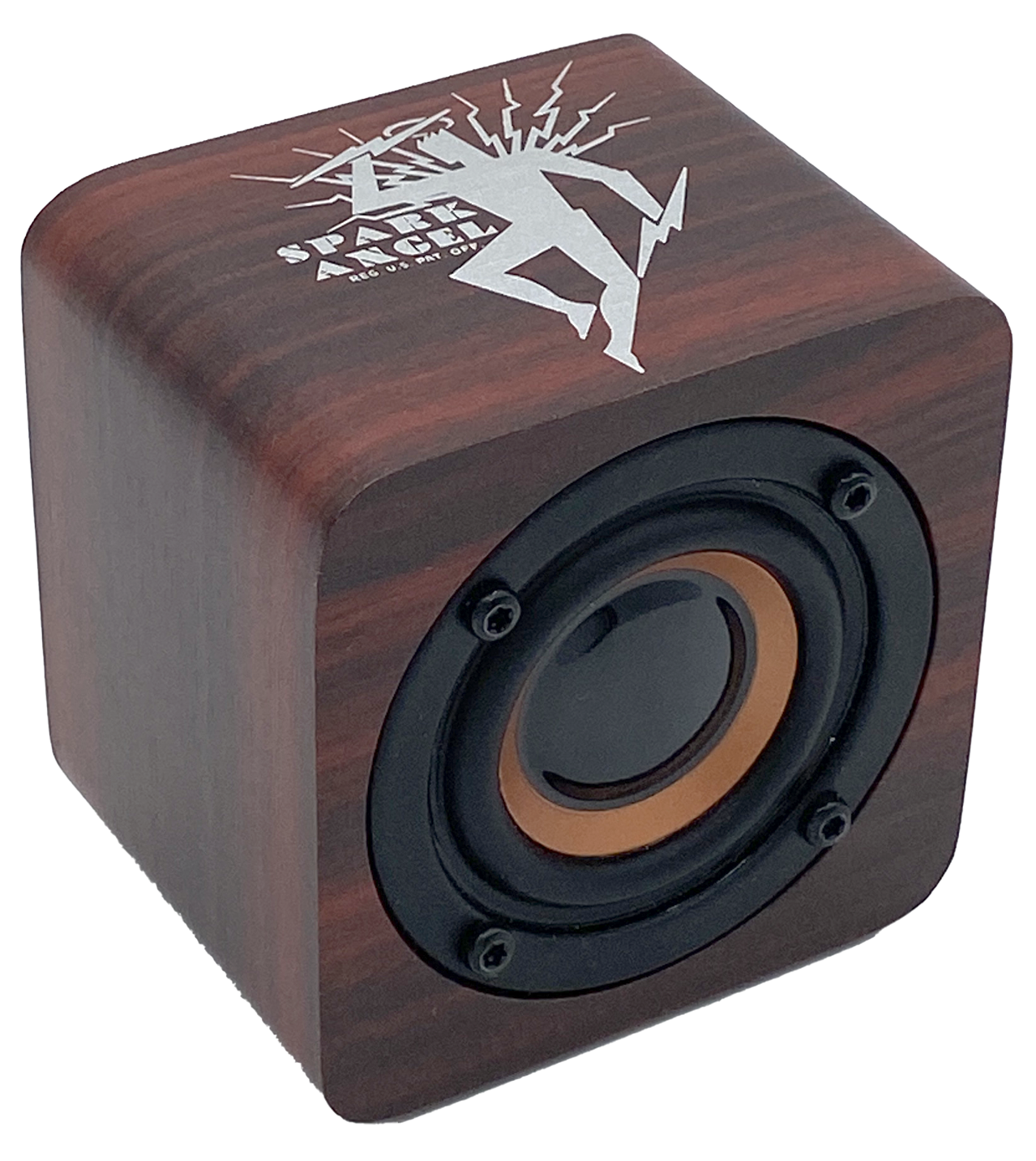 The functioning heart of the radio prop is this custom Bluetooth™ speaker. Complete instructions for its use are contained in the game book. By placing the speaker inside the oatmeal canister, Keepers can readily replicate the sound of a genuine 1920s/'30s homemade radio. By pairing the speaker with the playback device of your choice, you can play any audio file.
The functioning heart of the radio prop is this custom Bluetooth™ speaker. Complete instructions for its use are contained in the game book. By placing the speaker inside the oatmeal canister, Keepers can readily replicate the sound of a genuine 1920s/'30s homemade radio. By pairing the speaker with the playback device of your choice, you can play any audio file.
"Spark Angel" is the name of a fictional electronic parts company that Abner found advertised in one of his radio magazines. His home-built radio is made from various bits and pieces acquired from Spark Angel, among other places.
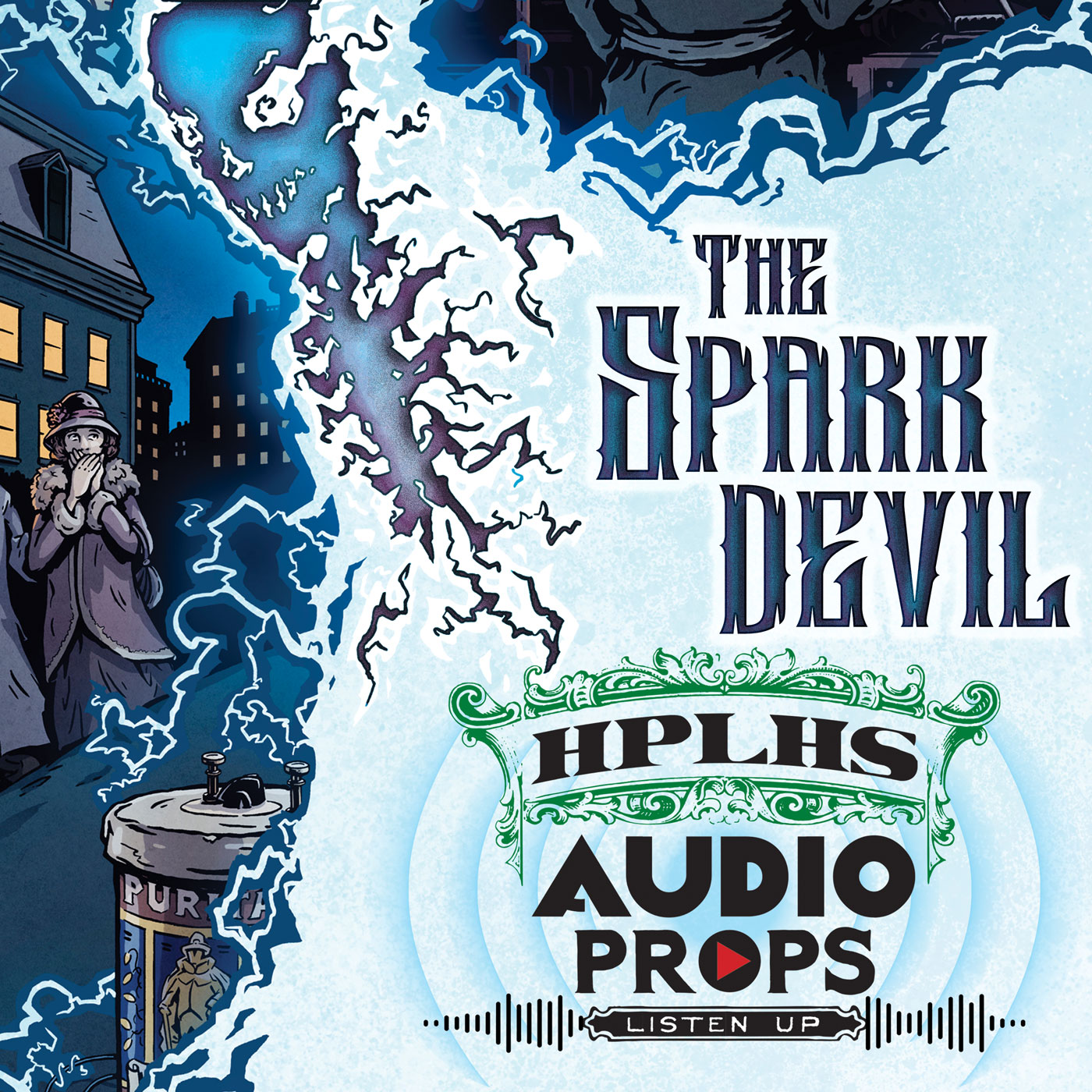 This adventure comes with 23 audio props, the first three of which are meant to be played specifically through Abner's oatmeal canister radio.
This adventure comes with 23 audio props, the first three of which are meant to be played specifically through Abner's oatmeal canister radio.
Both the game book and the "Read-Me" card that comes inside the Spark Devil box contain the URL where you can download the audio prop files. Once you've downloaded the files, you can use any Bluetooth-enabled playback device of your choice to play them through the Spark Angel speaker. Most phones and computers these days have this ability.
While the first three audio props are radio broadcasts meant to be played through Abner's radio, the others are live interactions with NPCs, and will probably sound better if you remove the speaker from the oatmeal canister, or play them through another sound system of your choosing. The HPLHS is grateful to our talented company of professional actors for lending their voice talents to this collection of characters.
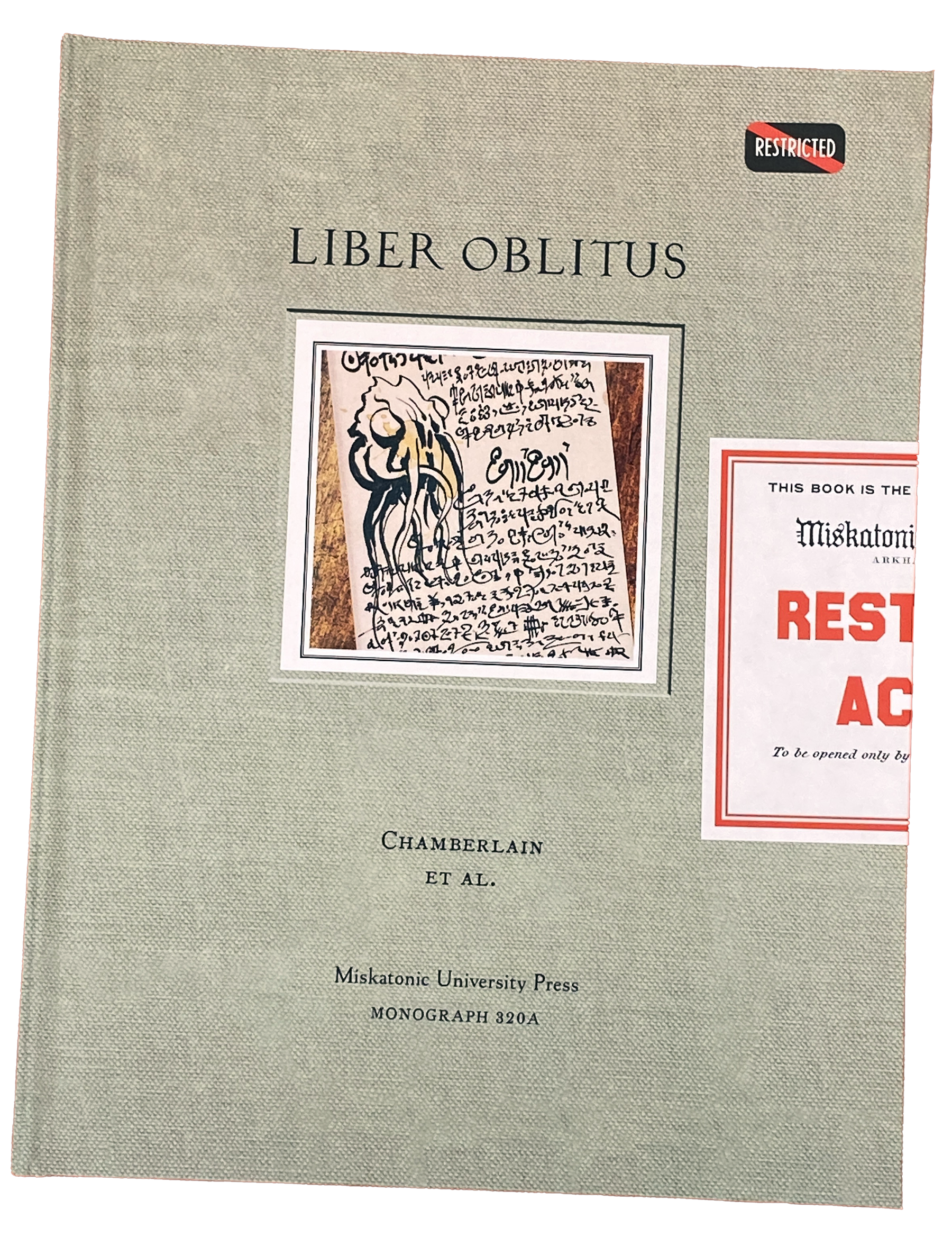 This prop set includes a hardback copy of the Miskatonic University monograph/facsimile Liber Oblitus. This book is available independently in the HPLHS online store, but the version included in this box has been prepared with additional features specifically for use as a prop in this game as a sealed Orne Library copy.
This prop set includes a hardback copy of the Miskatonic University monograph/facsimile Liber Oblitus. This book is available independently in the HPLHS online store, but the version included in this box has been prepared with additional features specifically for use as a prop in this game as a sealed Orne Library copy.
This book is packed with all kinds of detail, and reading it from cover to cover is in no way necessary (nor recommended) to play the game. But after the game is over the monograph can provide additional hours of fun and fascination for the Keeper and players alike.
It is sealed so that the players can have the thrill of opening it during the game, and the Keeper can share in that fun since they won’t know exactly what’s in it until the players do. We are providing some extra seals so that the Keeper can reseal the book for subsequent play sessions if desired. Or seal some other books you have to give them an added air of danger and mystery! We offer a free download of a Miskatonic University library book conversion kit in our prop document resources page.
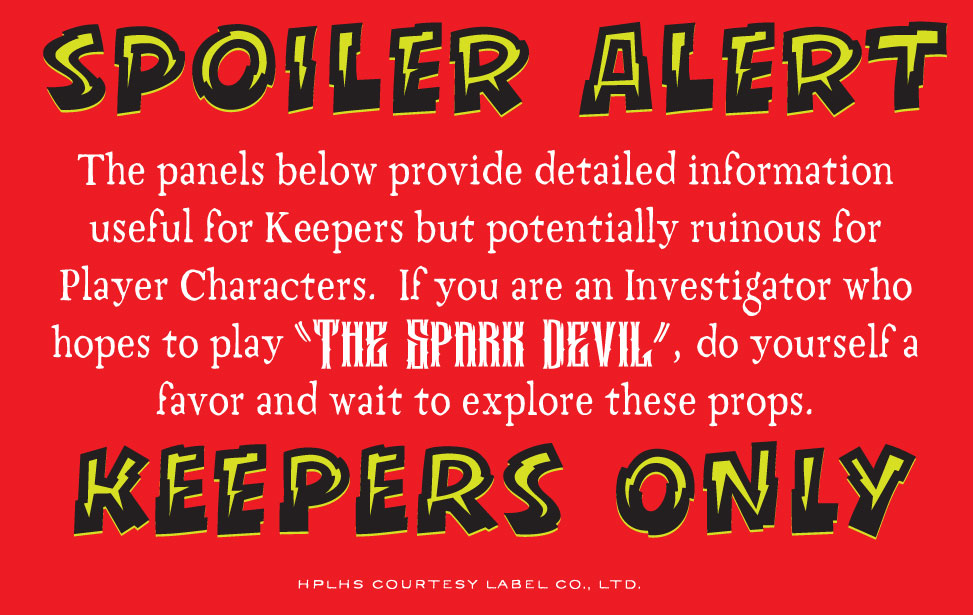 This section contains details that tend to reveal plot details about the game. If you are hoping to play The Spark Devil as an Investigator, your gaming experience will be enhanced if you don't know too much ahead of time. Look away while you still can!
This section contains details that tend to reveal plot details about the game. If you are hoping to play The Spark Devil as an Investigator, your gaming experience will be enhanced if you don't know too much ahead of time. Look away while you still can!
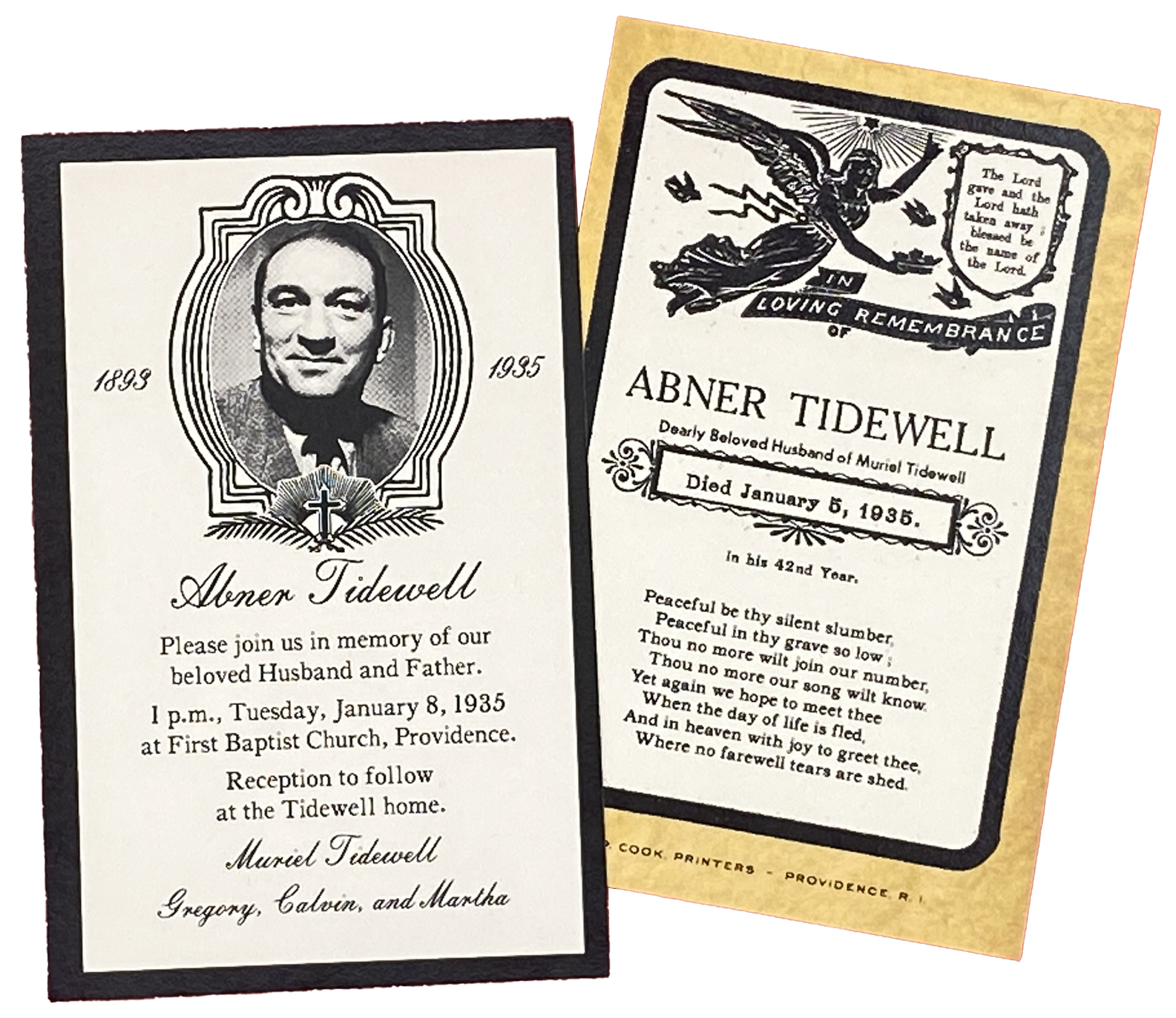 Based on stock designs that were commonly available from funeral directors at the time, this funeral card provides some clues for Investigators. Abner's memorial service takes place on a Tuesday, which coincides with the meeting of the Workmen's Co-Operative Association.
Based on stock designs that were commonly available from funeral directors at the time, this funeral card provides some clues for Investigators. Abner's memorial service takes place on a Tuesday, which coincides with the meeting of the Workmen's Co-Operative Association.
Abner is played in the photograph on this card by Academy Award-winning actor Victor McLaglen.
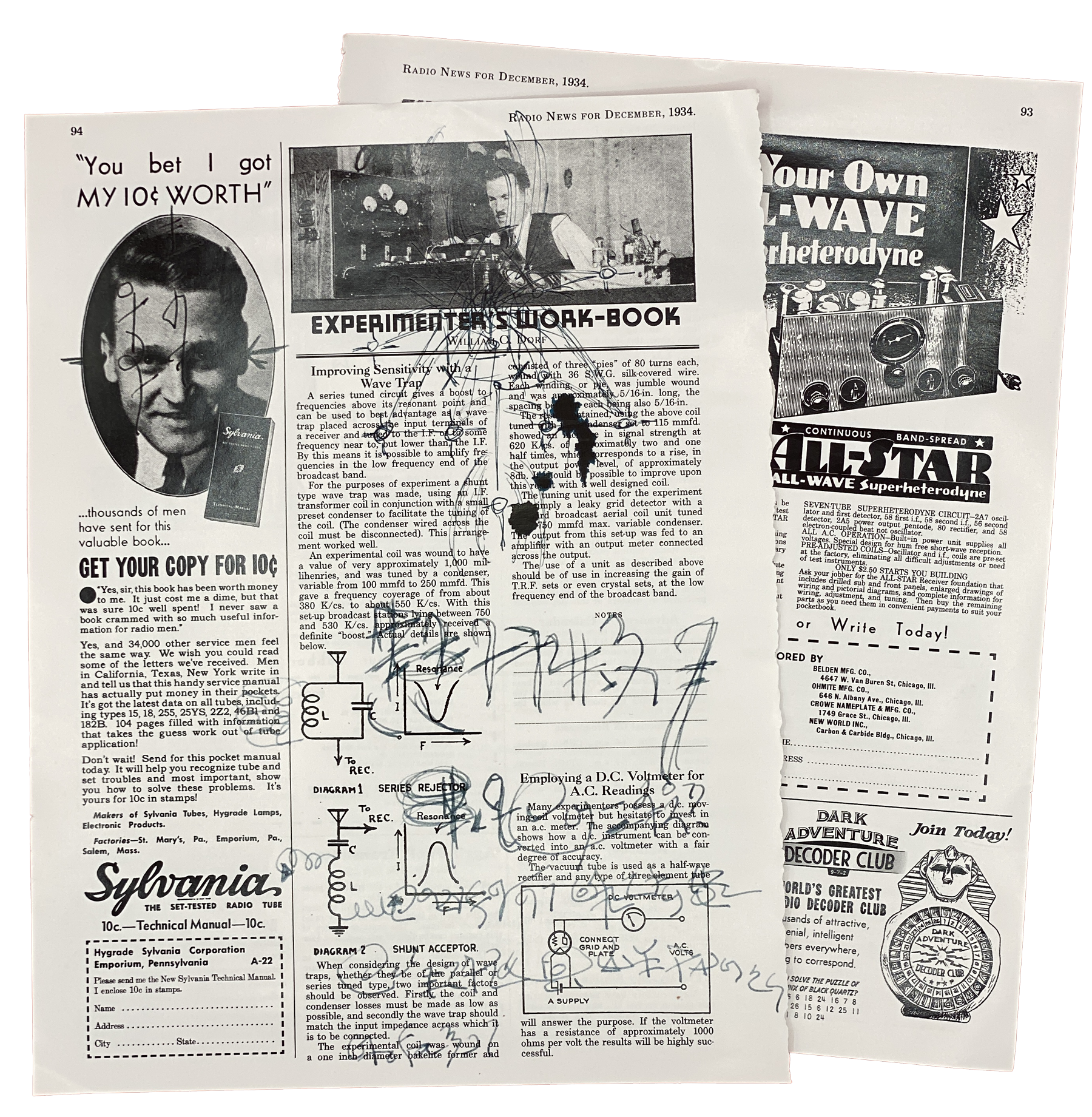 This prop is a page torn from one of Abner's radio magazines, on which he has scribbled some very disturbing and cryptic notes. The item combines articles and graphics from real radio magazines of the day, including Radio News, Radio-Craft and Short Wave Craft. You can see the complete issue of Radio News for January, 1935, the month when this game takes place, HERE.
This prop is a page torn from one of Abner's radio magazines, on which he has scribbled some very disturbing and cryptic notes. The item combines articles and graphics from real radio magazines of the day, including Radio News, Radio-Craft and Short Wave Craft. You can see the complete issue of Radio News for January, 1935, the month when this game takes place, HERE.
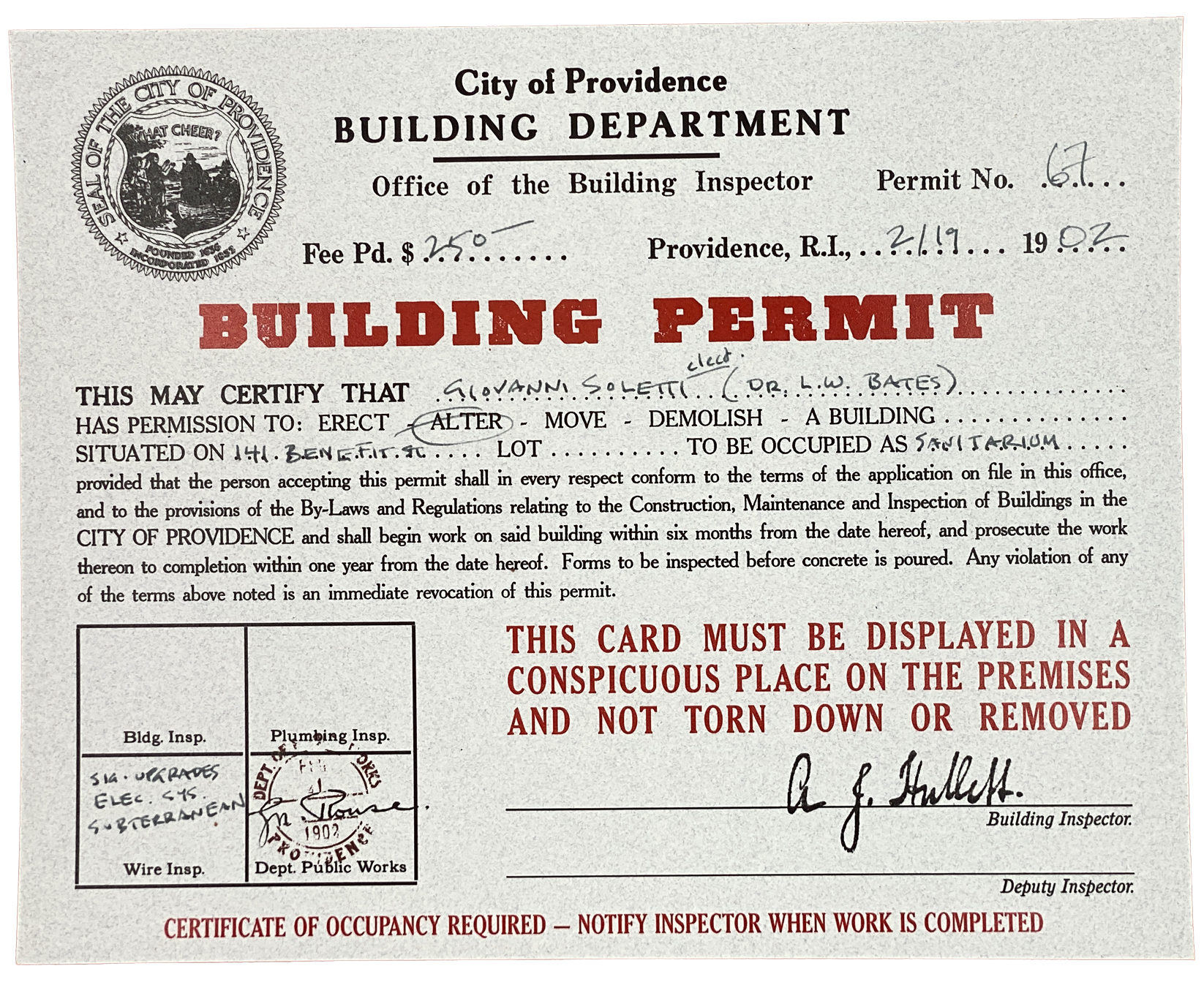 Found at the Providence hall of records, this prop is based on real city permits of the time. It can lead Investigators to Joe Soletti, and/or to the basement at 141 Benefit Street.
Found at the Providence hall of records, this prop is based on real city permits of the time. It can lead Investigators to Joe Soletti, and/or to the basement at 141 Benefit Street.
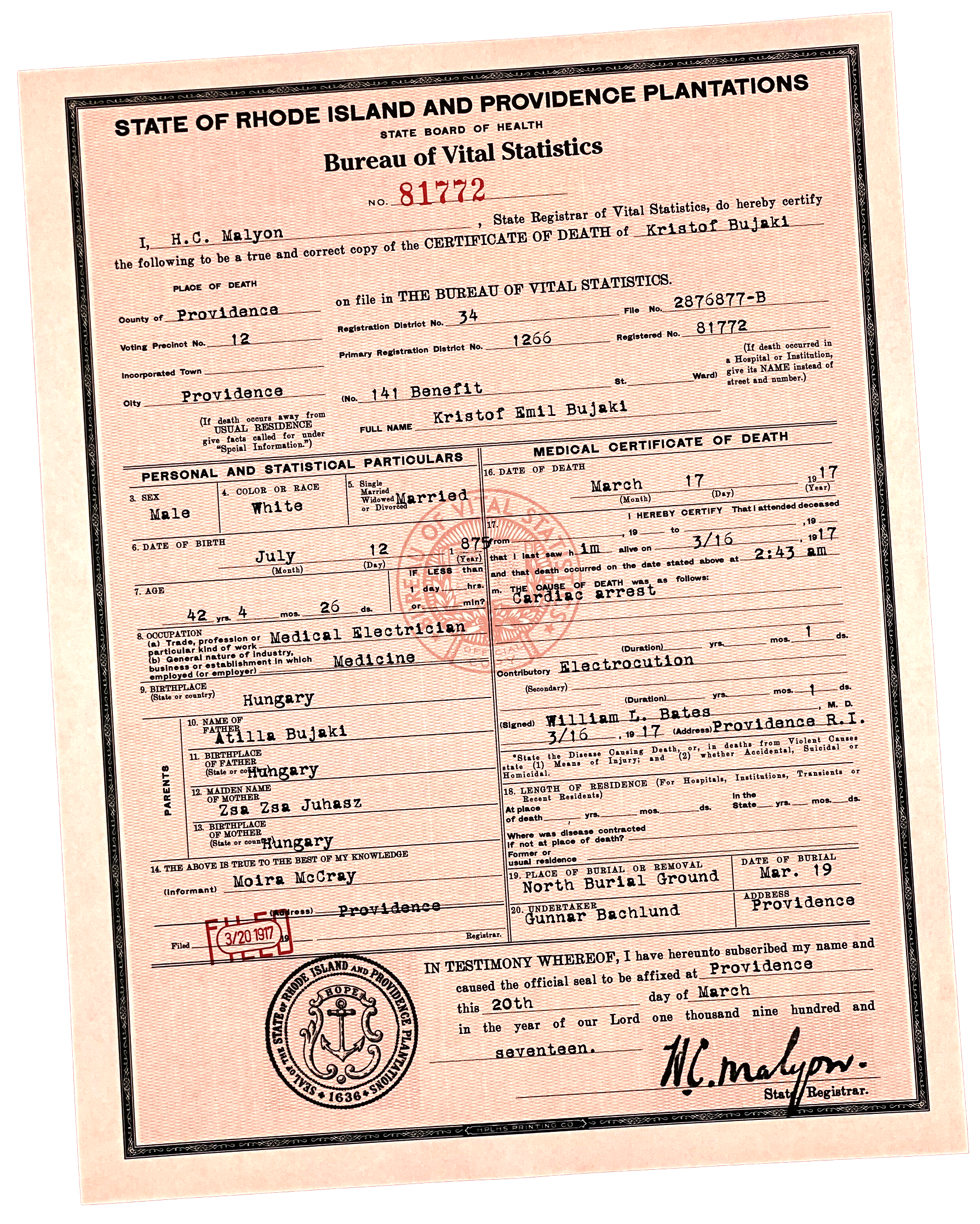 Found at the Providence hall of records, this document provides mostly true information and a couple of fibs. Although the cause of Bujaki's death was not actually cardiac arrest, it did take place at 141 Benefit St.
Found at the Providence hall of records, this document provides mostly true information and a couple of fibs. Although the cause of Bujaki's death was not actually cardiac arrest, it did take place at 141 Benefit St.
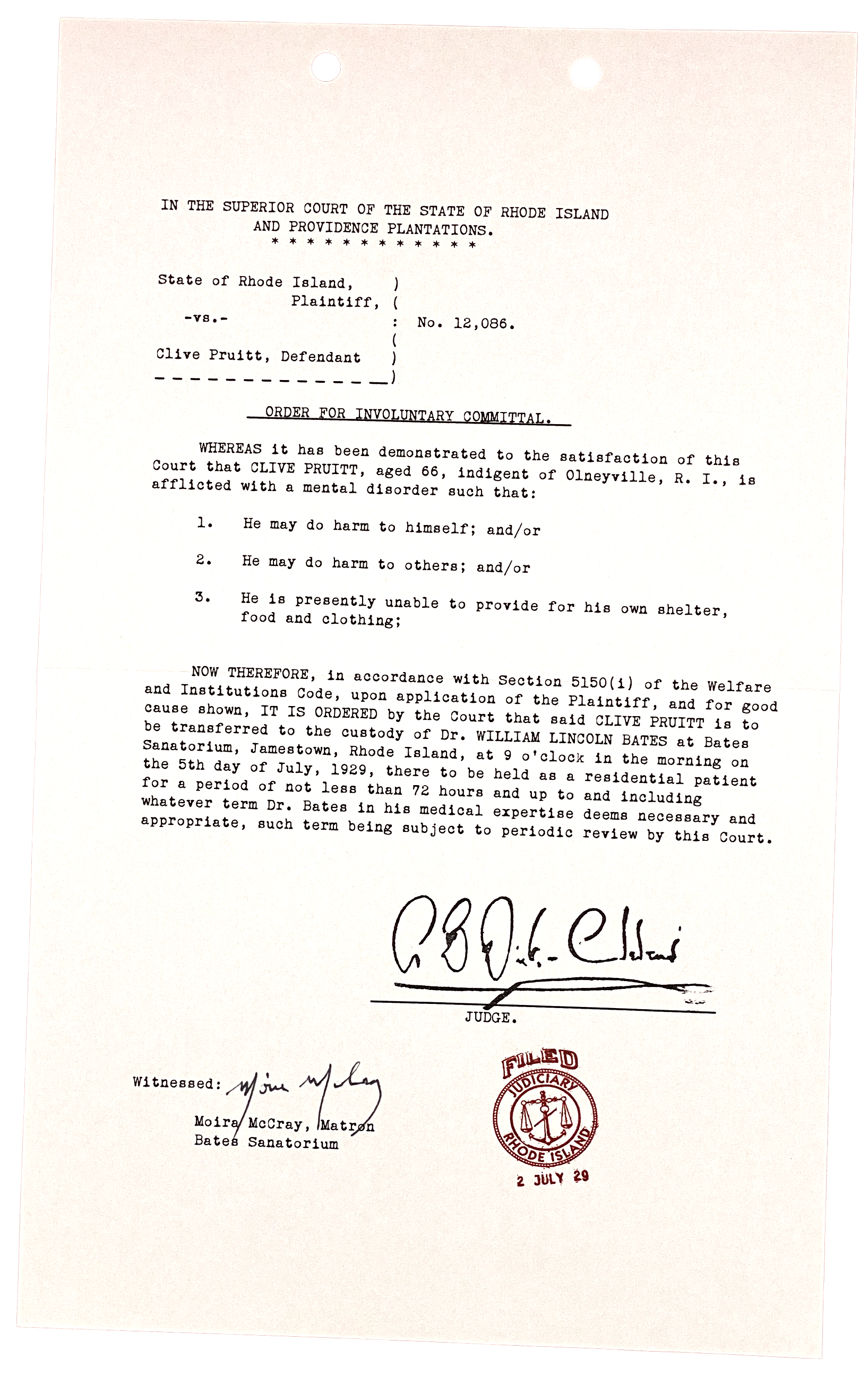 In the 1930s, involuntary psychiatric commitment was not an uncommon practice, and the legal documents making it possible were dreadfully routine. Investigators might find copies of this document in the files of the courthouse, the health department, or McCray's office.
In the 1930s, involuntary psychiatric commitment was not an uncommon practice, and the legal documents making it possible were dreadfully routine. Investigators might find copies of this document in the files of the courthouse, the health department, or McCray's office.
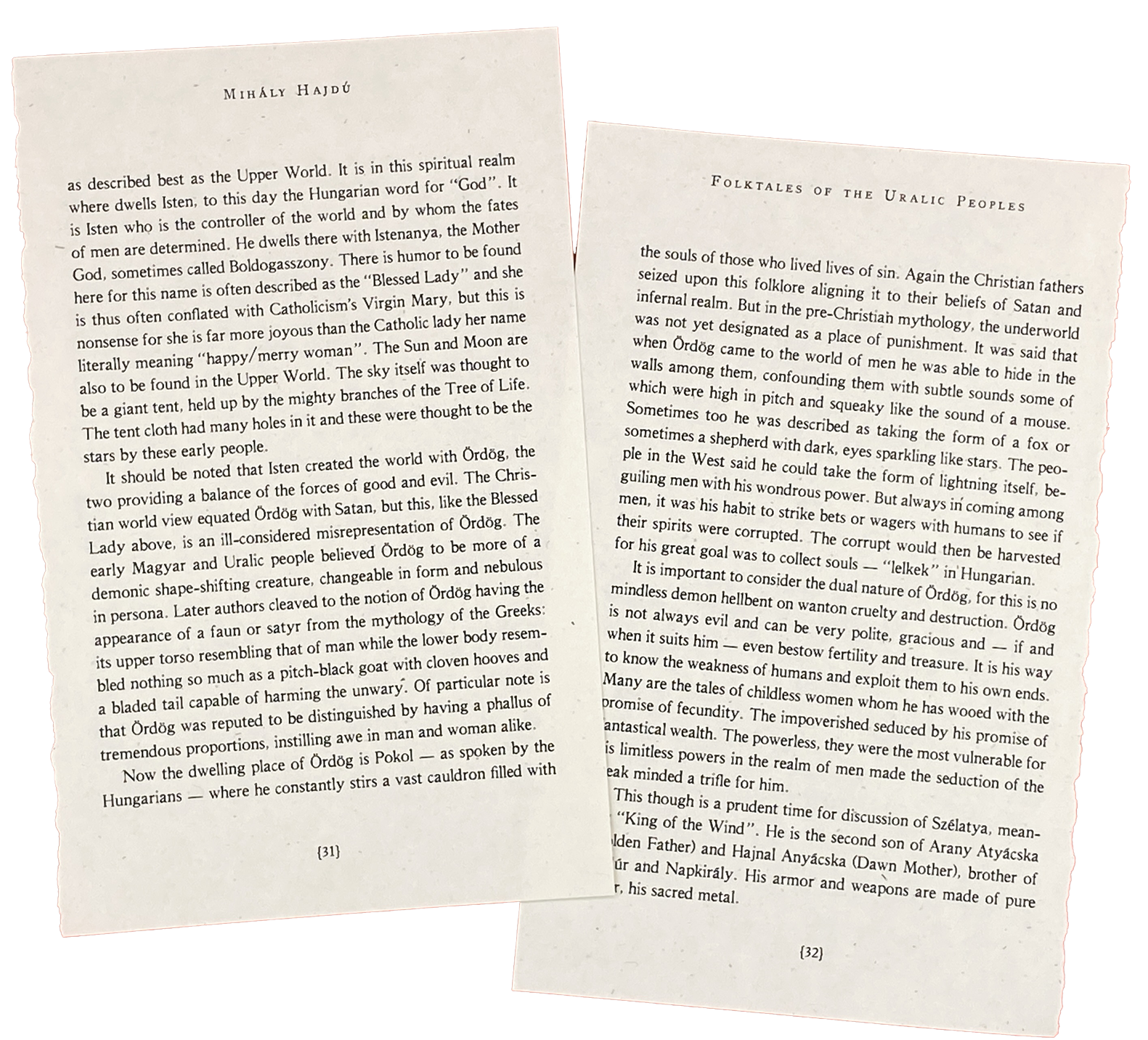 This prop is a page from a made-up book published in the late 1800s. The cult of the Spark Devil is obscure and highly secretive, so this glancing reference is the only one the Investigators can find.
This prop is a page from a made-up book published in the late 1800s. The cult of the Spark Devil is obscure and highly secretive, so this glancing reference is the only one the Investigators can find.
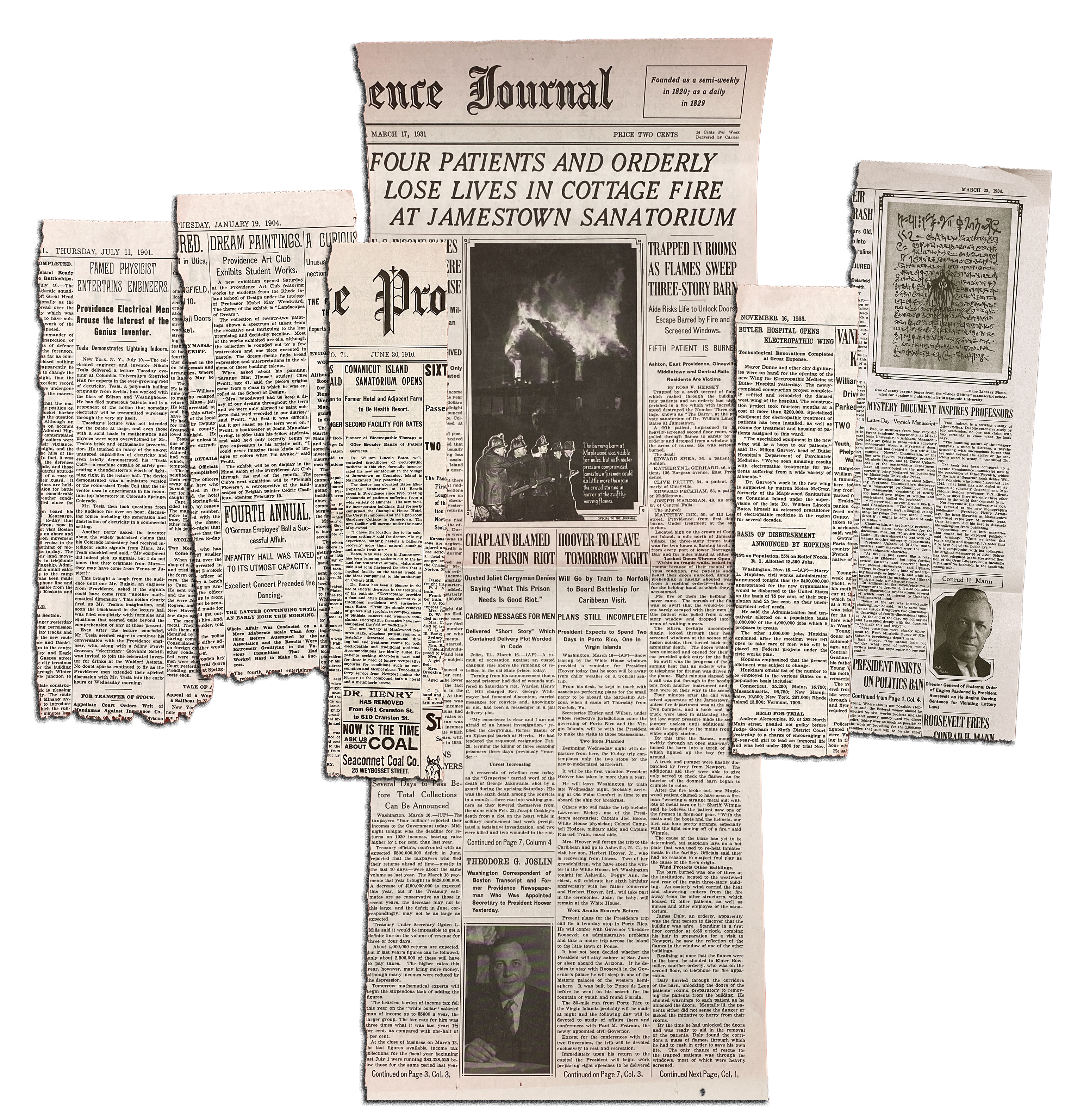 The prop set includes six clippings from The Providence Journal, ranging from 1901 to 1934. The largest is an entire half of the front page of the paper, and is a detailed replica of the actual coverage of the fire at Maplewood, which was a real historical event. Except for the inclusion of a couple of fictional characters and incidents, the story is pulled verbatim from the real coverage. The photos from the real newspaper were not of sufficiently high quality for reprinting, so they have been mocked up using other sources.
The prop set includes six clippings from The Providence Journal, ranging from 1901 to 1934. The largest is an entire half of the front page of the paper, and is a detailed replica of the actual coverage of the fire at Maplewood, which was a real historical event. Except for the inclusion of a couple of fictional characters and incidents, the story is pulled verbatim from the real coverage. The photos from the real newspaper were not of sufficiently high quality for reprinting, so they have been mocked up using other sources.
Investigators might find any/all of these items at the public library or in the morgue files at The Providence Journal itself. Muriel Tidewell herself might be able to provide the most recent one from the clutter of her own home, if the Investigators need a shove in that direction.
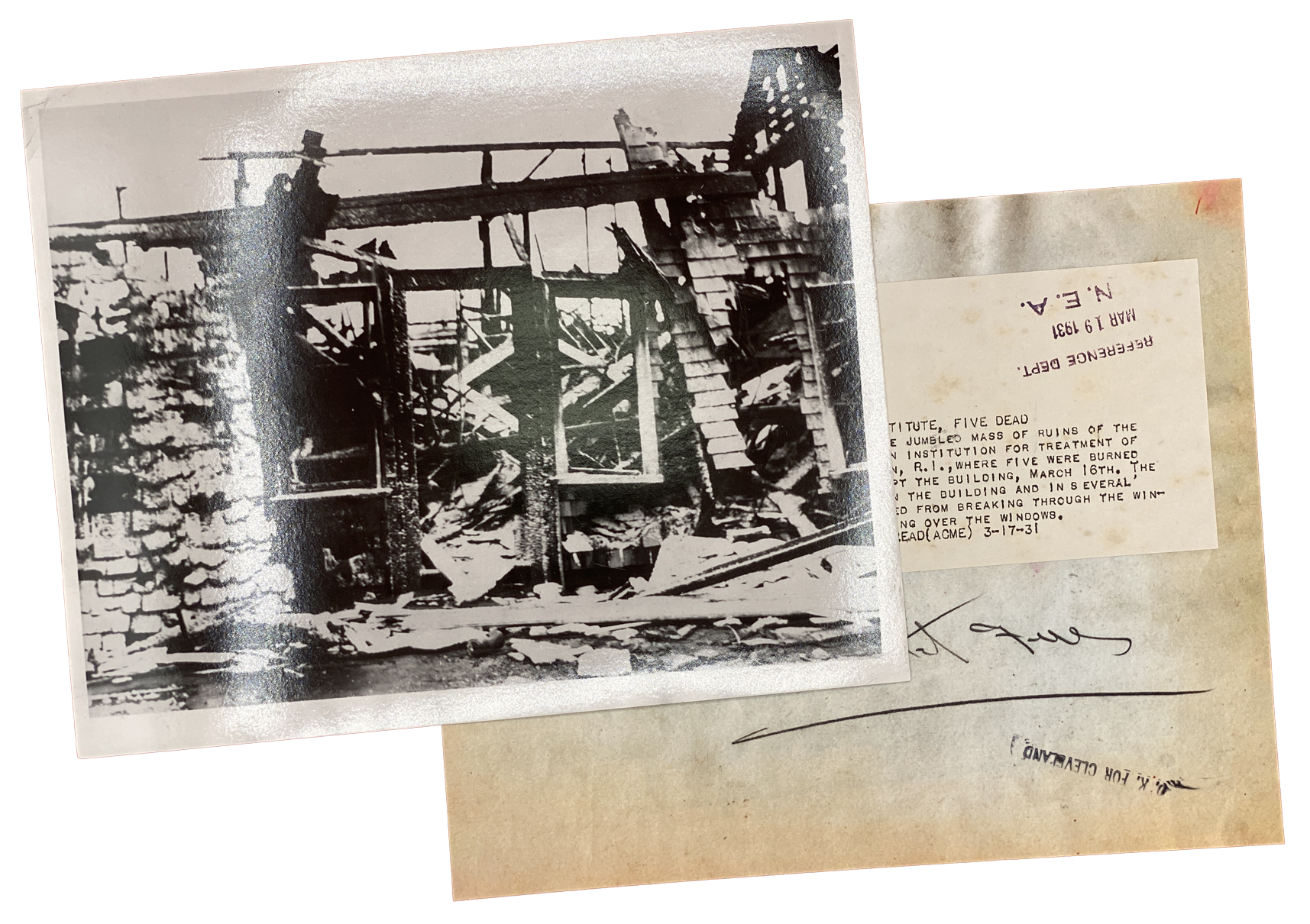 This is a replica of an actual syndicated press photograph of the real building at Maplewood that burned down on the night of March 17, 1931. All of the notations on the back are recreated from the original. This item can only be found by the Investigators in the morgue at the offices of The Providence Journal.
This is a replica of an actual syndicated press photograph of the real building at Maplewood that burned down on the night of March 17, 1931. All of the notations on the back are recreated from the original. This item can only be found by the Investigators in the morgue at the offices of The Providence Journal.
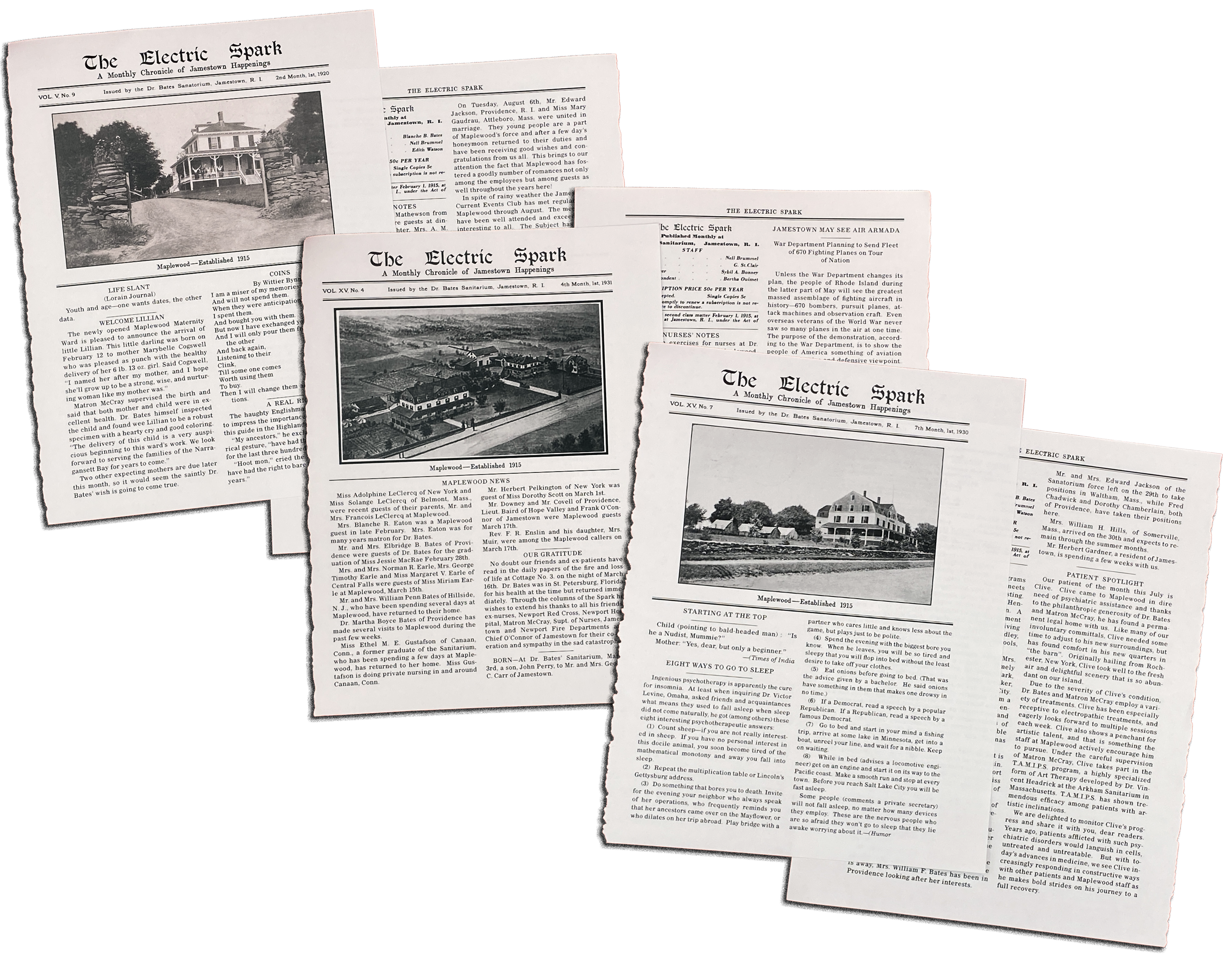 Dr. Bates sanitarium at Maplewood on Conanicut Island was a real place, and might well have been — at least in part — the inspiration for the asylum from which Charles Dexter Ward is reported to have escaped in Lovecraft's story "The Case of Charles Dexter Ward". During HPL's lifetime it was a well-known local institution, the second of two sanitariums run by William Lincoln Bates. They really did have an in-house newsletter called "The Electric Spark", and we are very grateful to the Jamestown Historical Society for providing us access to some copies, on which these prop replicas are based.
Dr. Bates sanitarium at Maplewood on Conanicut Island was a real place, and might well have been — at least in part — the inspiration for the asylum from which Charles Dexter Ward is reported to have escaped in Lovecraft's story "The Case of Charles Dexter Ward". During HPL's lifetime it was a well-known local institution, the second of two sanitariums run by William Lincoln Bates. They really did have an in-house newsletter called "The Electric Spark", and we are very grateful to the Jamestown Historical Society for providing us access to some copies, on which these prop replicas are based.
Some people use the word "sanitarium" and some use "sanatorium". In the 1930s the words were basically interchangeable, and technically still are, although these days "sanitarium" has come more to mean a mental institution, and "sanatorium" refers more a health spa. Bates' facilities were both of those things, although Butler Hospital was more of a sanitarium than a sanatorium. Sanatoriums were once quite fashionable.
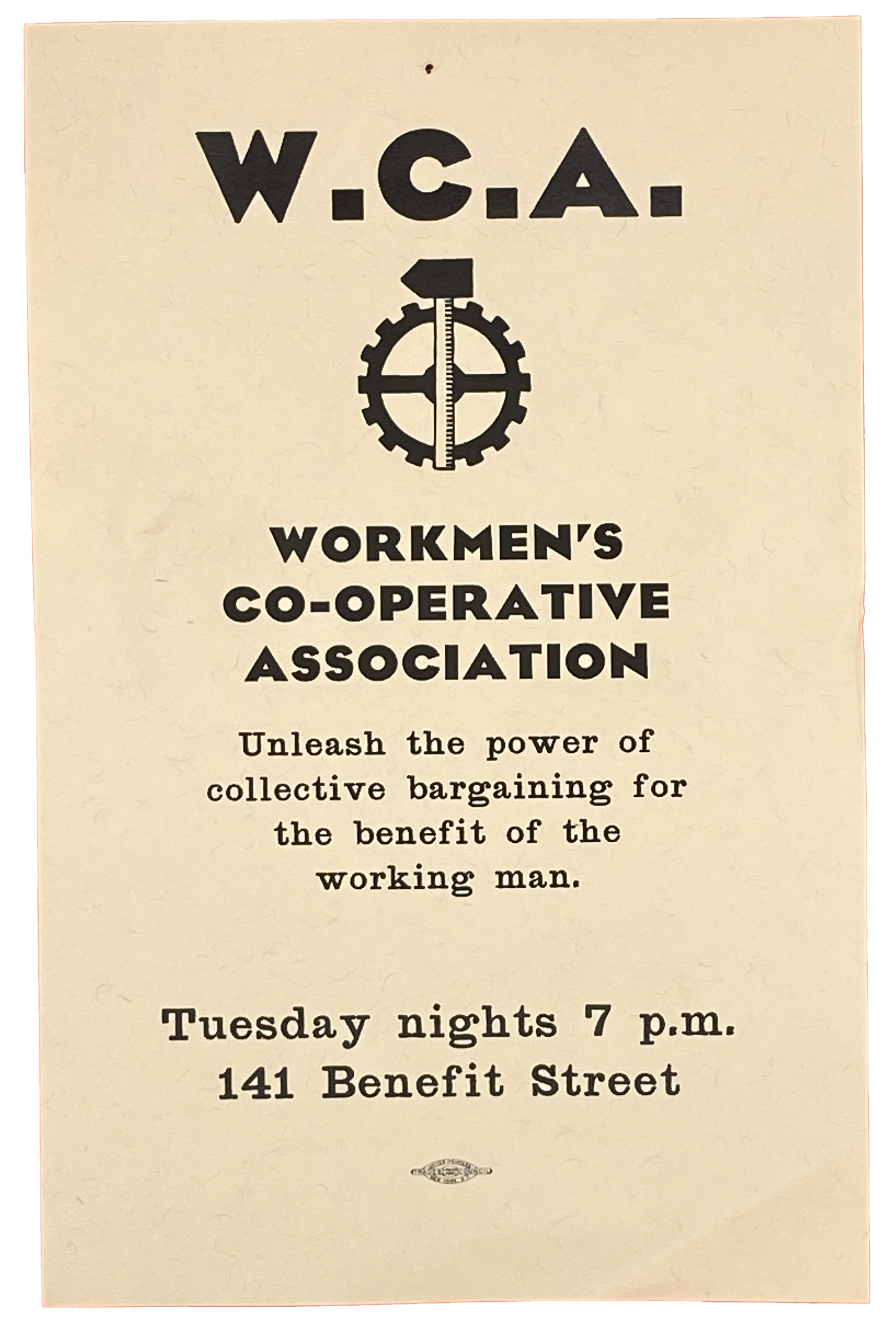 Found on the bulletin board at The Bookstore, this very businesslike flyer has been a bit crumpled and pre-drilled with a thumbtack hole at the top. The union label at the bottom was commonly included in print jobs of the day, and in 1935 is a political statement in its own right.
Found on the bulletin board at The Bookstore, this very businesslike flyer has been a bit crumpled and pre-drilled with a thumbtack hole at the top. The union label at the bottom was commonly included in print jobs of the day, and in 1935 is a political statement in its own right.
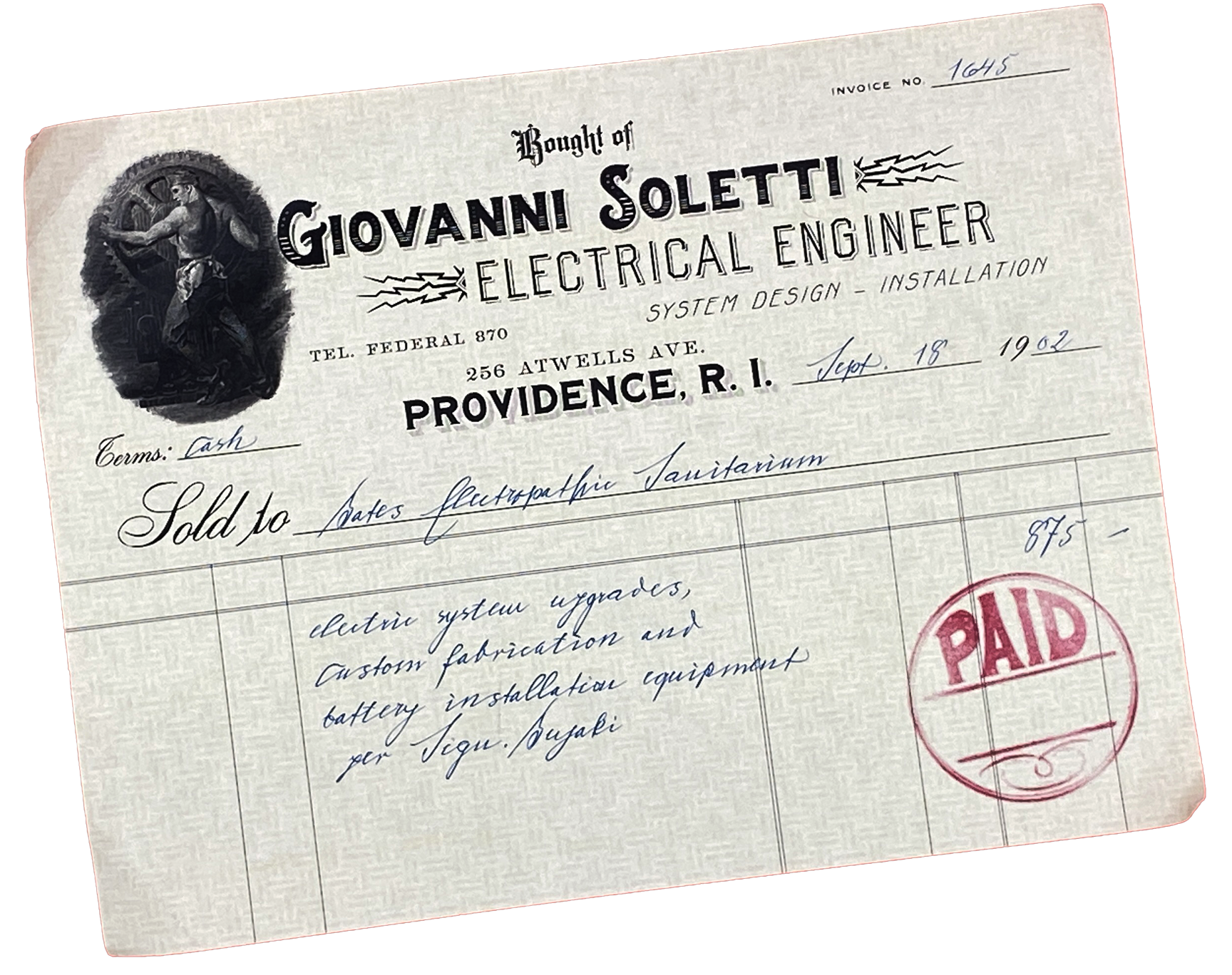 This item is to be found at 141 Benefit St., where it has been pinned up as a curiosity by the working men who now occupy the rooms on the second floor. This document is 34 years old, and has been distressed to suggest its age. It can lead to Joe Soletti, and/or to the strange machinery in the basement.
This item is to be found at 141 Benefit St., where it has been pinned up as a curiosity by the working men who now occupy the rooms on the second floor. This document is 34 years old, and has been distressed to suggest its age. It can lead to Joe Soletti, and/or to the strange machinery in the basement.
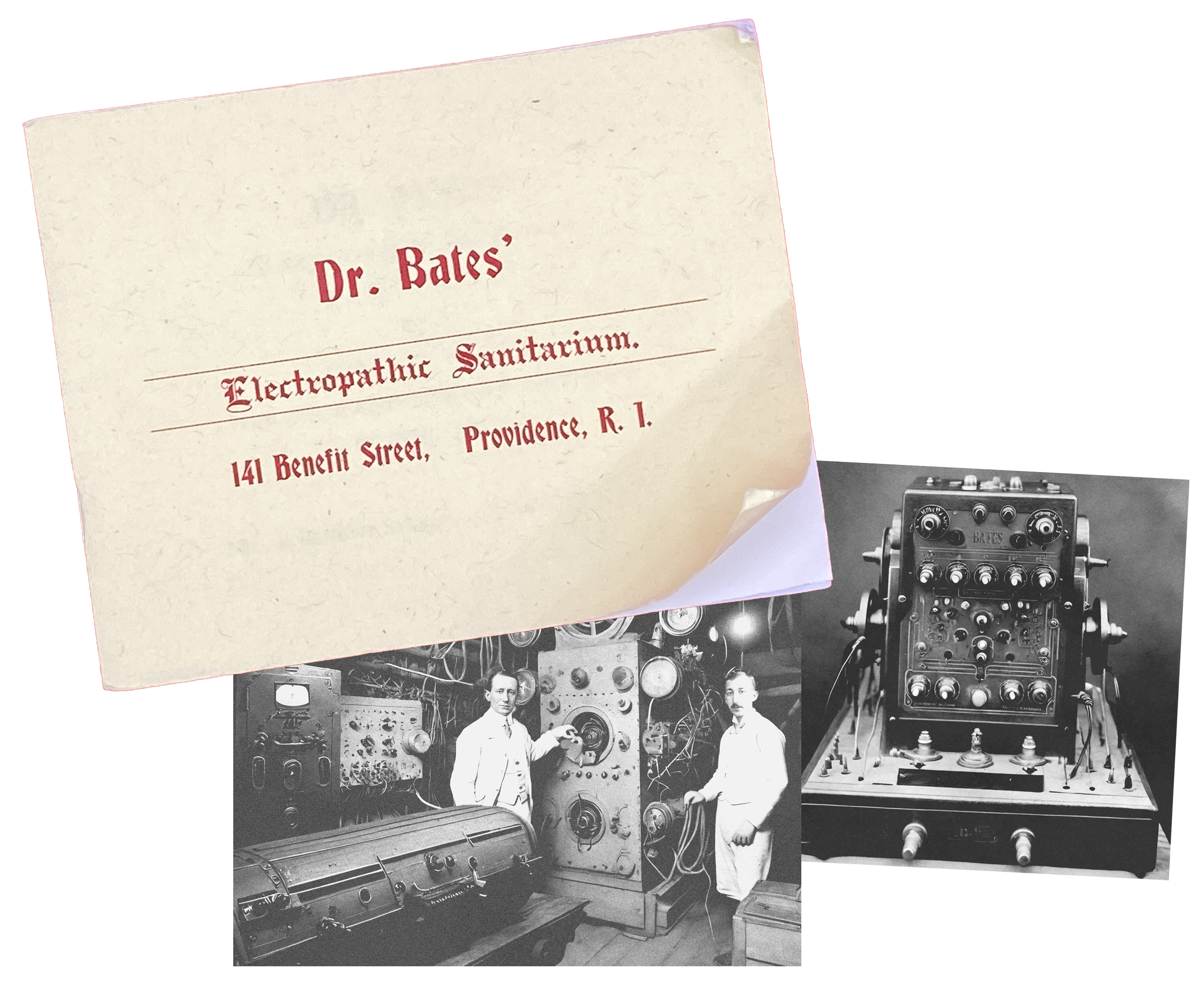 This item is found among the possessions of Joe Soletti, who kept it as a souvenir of his time working at the Bates Electropathic Sanitarium because it includes a picture of himself. This 32-page booklet is a painstaking replica of a real brochure published in the 1890s by William L. Bates promoting his sanitarium. All of the photos it contains, except the two shown here, are from the original brochure. These two are fictional composites created for the game. Bujaki is played in the photograph by famous Italian electrical engineer Guglielmo Marconi, and Joe Soletti is played by George de Hevesy, a Hungarian Nobel Prize-winning radiochemist. We are very grateful to the Jamestown Historical Society for providing access to the original document.
This item is found among the possessions of Joe Soletti, who kept it as a souvenir of his time working at the Bates Electropathic Sanitarium because it includes a picture of himself. This 32-page booklet is a painstaking replica of a real brochure published in the 1890s by William L. Bates promoting his sanitarium. All of the photos it contains, except the two shown here, are from the original brochure. These two are fictional composites created for the game. Bujaki is played in the photograph by famous Italian electrical engineer Guglielmo Marconi, and Joe Soletti is played by George de Hevesy, a Hungarian Nobel Prize-winning radiochemist. We are very grateful to the Jamestown Historical Society for providing access to the original document.
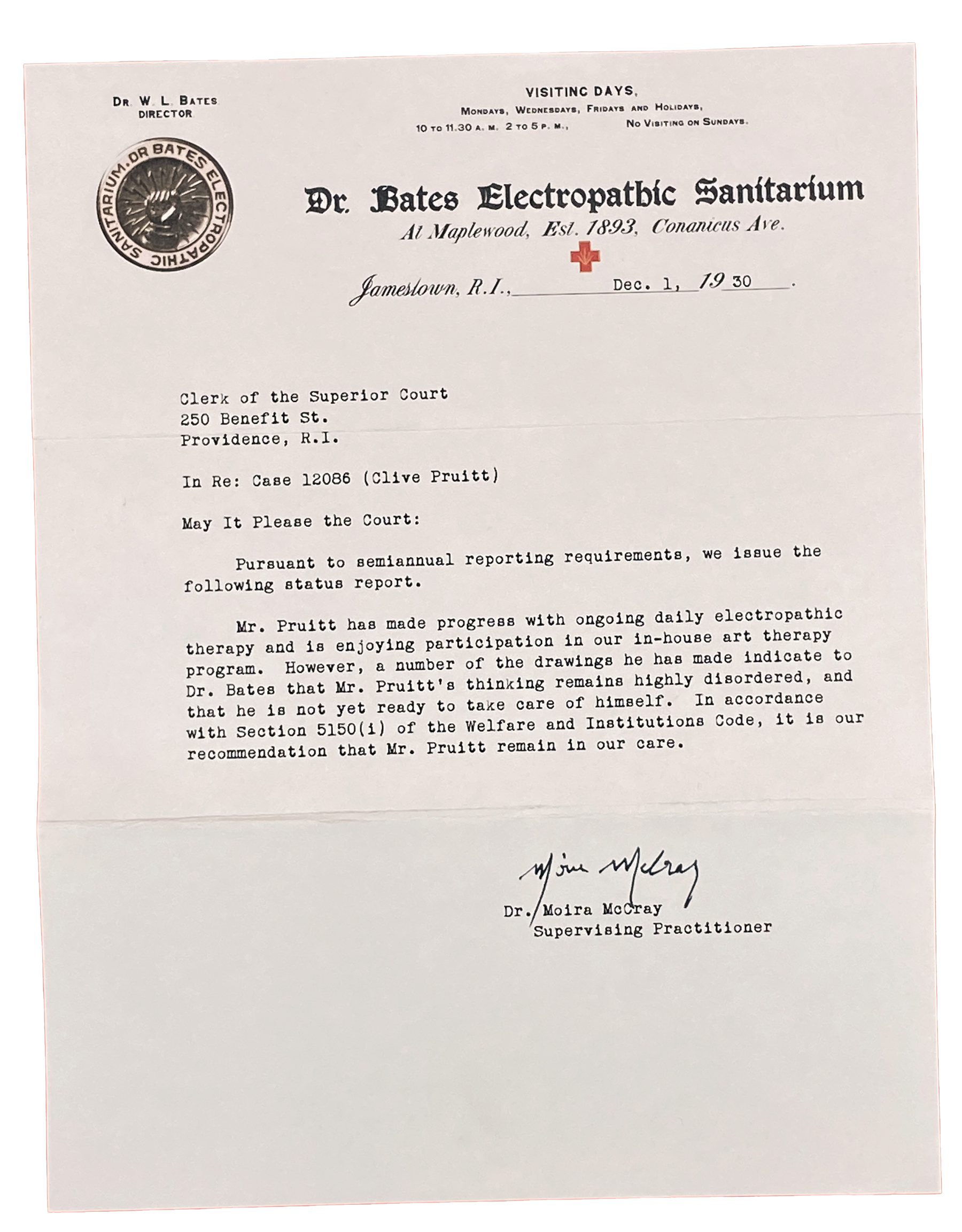 This item is to be found in the old patient files at Maplewood, and ties Clive Pruitt to Moira McCray and the art therapy program. The letterhead is fictional, although the logo at the top left is the actual pin given to nurses by Dr. Bates.
This item is to be found in the old patient files at Maplewood, and ties Clive Pruitt to Moira McCray and the art therapy program. The letterhead is fictional, although the logo at the top left is the actual pin given to nurses by Dr. Bates.
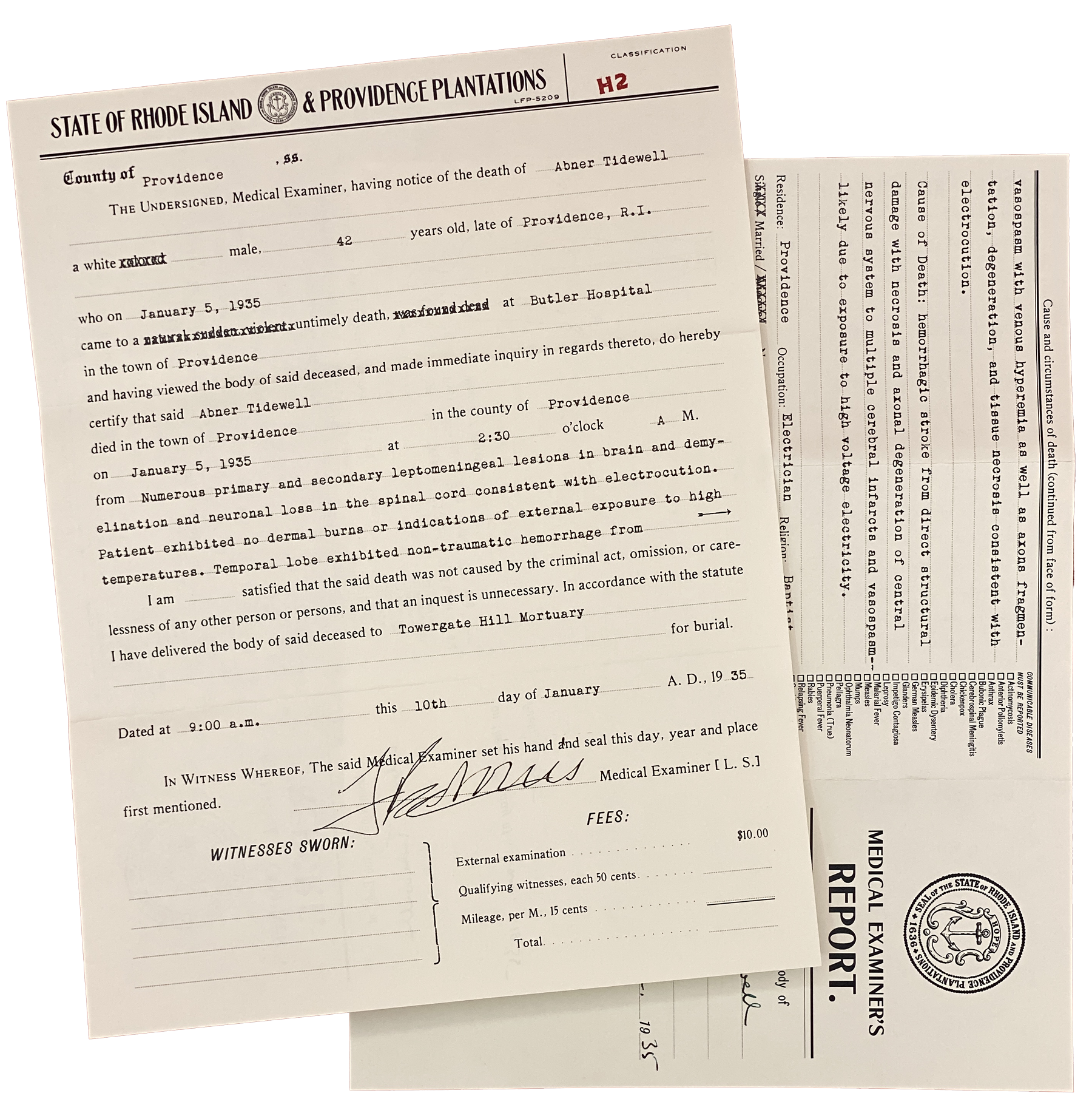 This prop is a composite of various real autopsy reports of the time, and provides numerous disturbing details about Abner Tidewell's untimely death.
This prop is a composite of various real autopsy reports of the time, and provides numerous disturbing details about Abner Tidewell's untimely death.
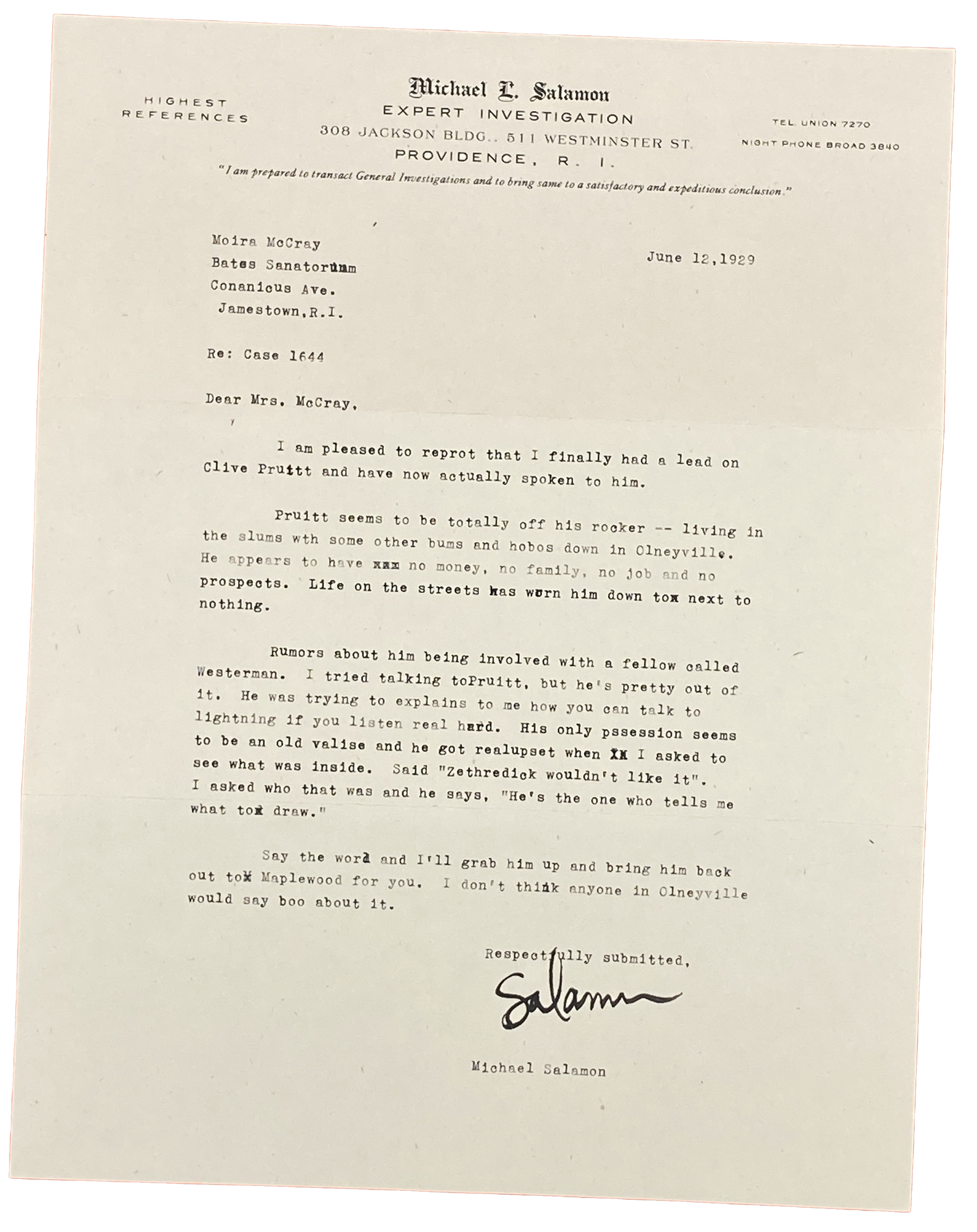 This badly-typed letter is to be found in the files of Moira McCray at Butler Hospital. The letterhead is based on that of a real private investigator from Providence we found in the city directory of 1921.
This badly-typed letter is to be found in the files of Moira McCray at Butler Hospital. The letterhead is based on that of a real private investigator from Providence we found in the city directory of 1921.
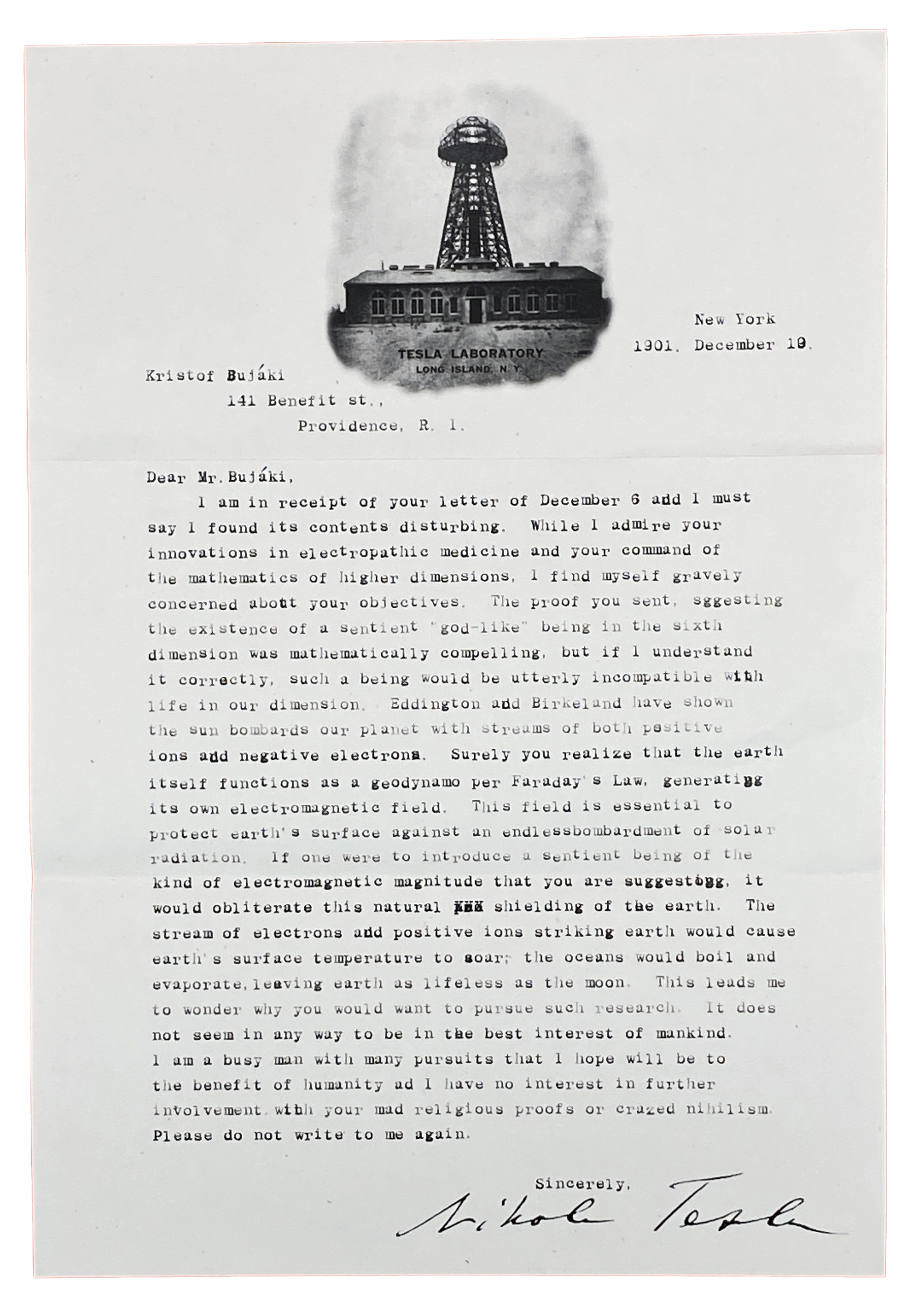 This letter is one of many to be found in the possession of Moira McCray, if not in her office at Butler Hospital, then in her home. It is based on a sample of Nikola Tesla's actual stationery, and the signature is a replica of his real one. The prop has been lightly distressed due to its age.
This letter is one of many to be found in the possession of Moira McCray, if not in her office at Butler Hospital, then in her home. It is based on a sample of Nikola Tesla's actual stationery, and the signature is a replica of his real one. The prop has been lightly distressed due to its age.
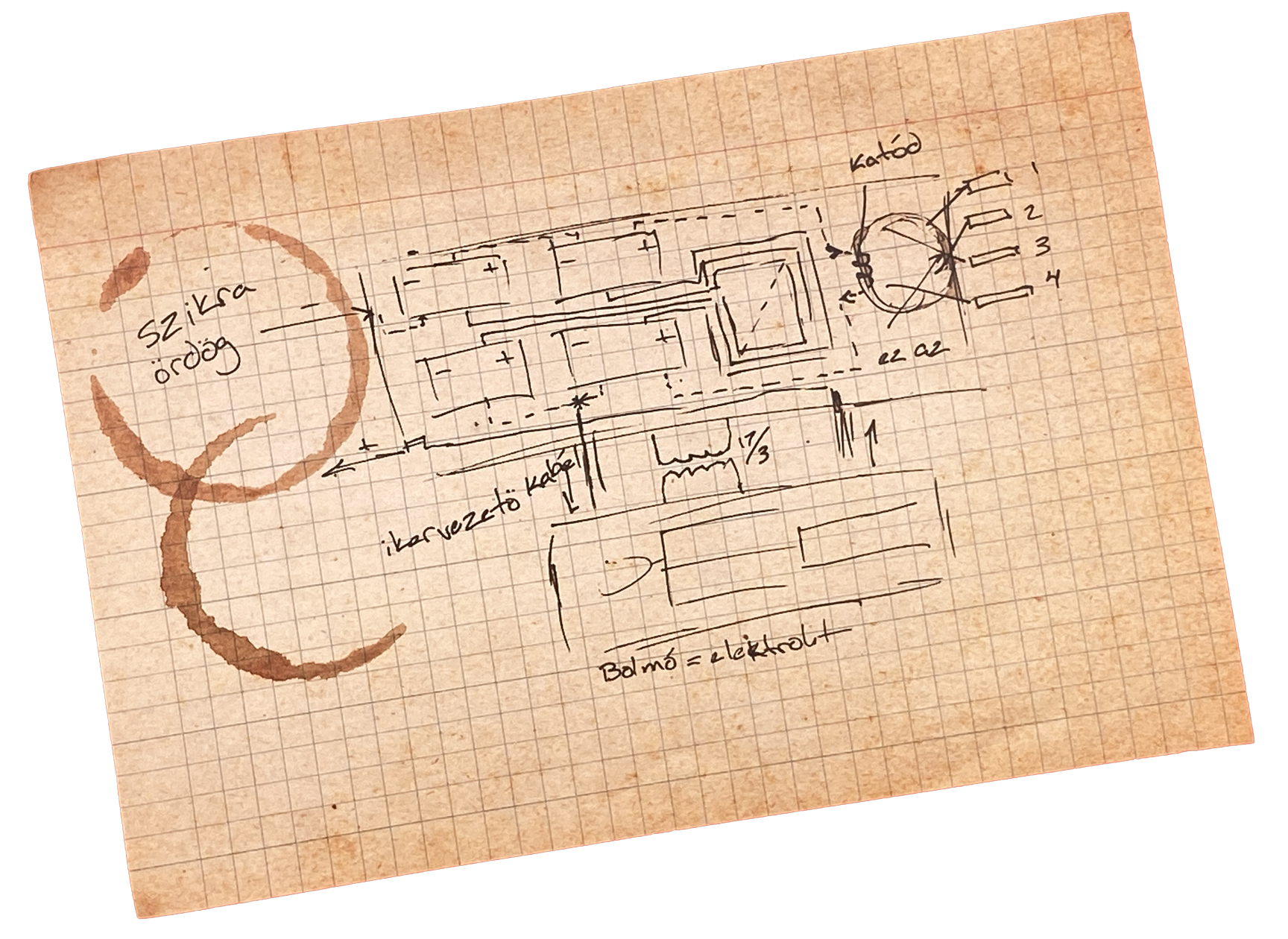 This crumpled old sheet is to be found in the possession of Moira McCray. It is one of many pages of notes and diagrams drawn by her deceased husband, Kristof Bujáki. It makes little sense to anyone without Electrical Repair skill, and not much more to people who have it, but suggests terrible things regarding electricity and human victims.
This crumpled old sheet is to be found in the possession of Moira McCray. It is one of many pages of notes and diagrams drawn by her deceased husband, Kristof Bujáki. It makes little sense to anyone without Electrical Repair skill, and not much more to people who have it, but suggests terrible things regarding electricity and human victims.
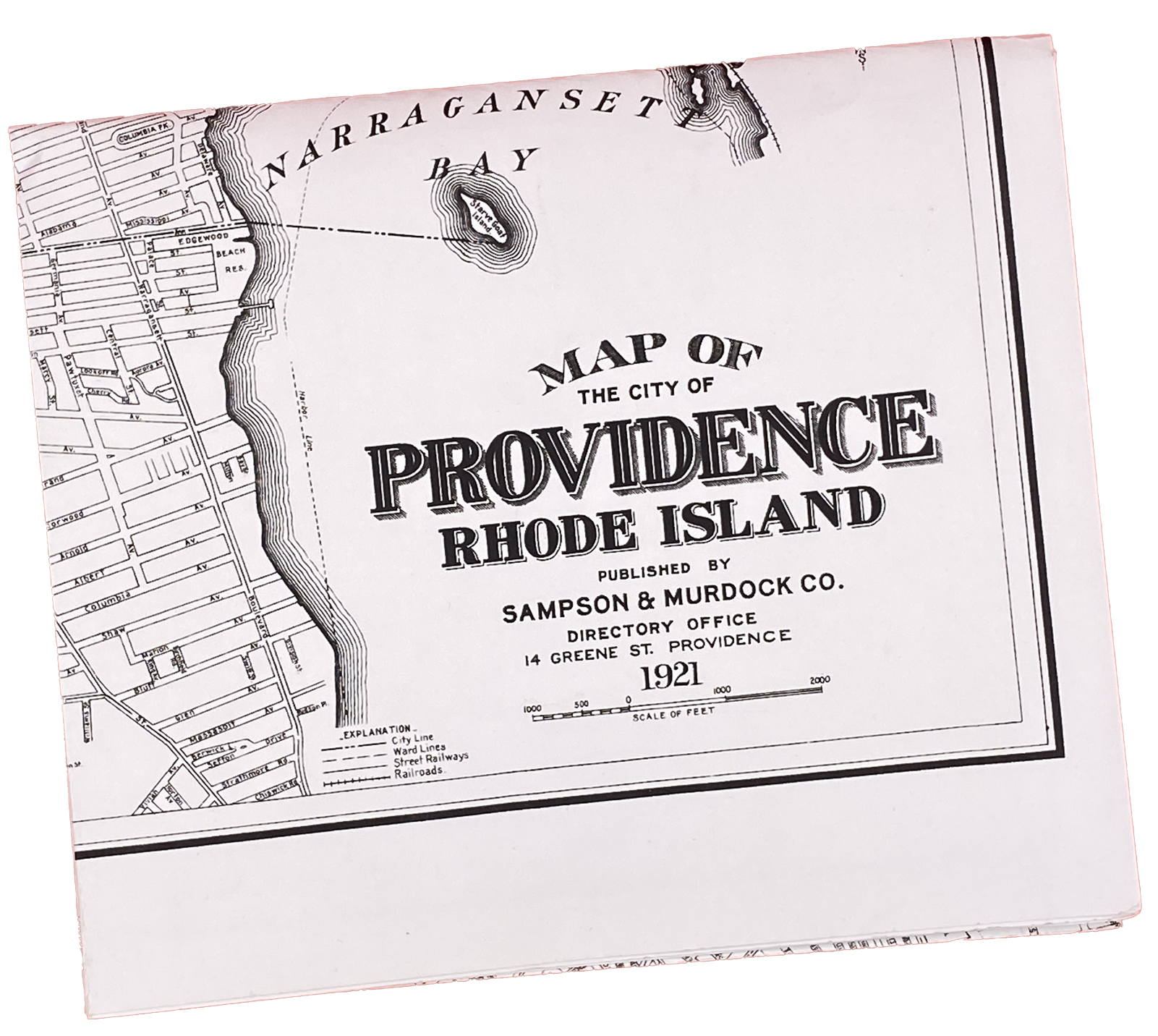 This large-format map is a painstaking restoration of the map included with the 1921 Providence city directory. The original was printed on tissue paper.
This large-format map is a painstaking restoration of the map included with the 1921 Providence city directory. The original was printed on tissue paper.
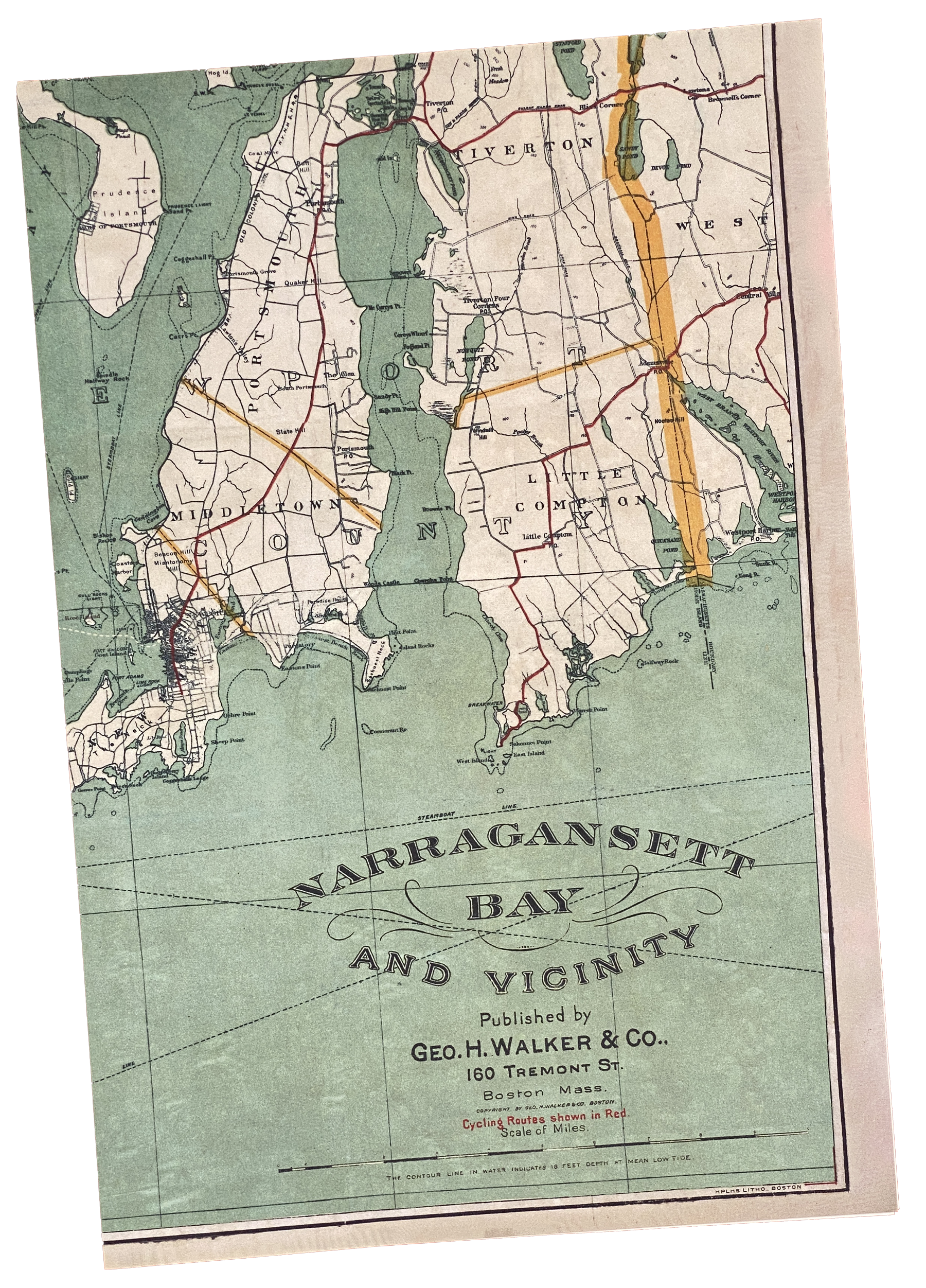 This large-format map is based on one from the 1890s, and shows the relative locations of Providence and Conanicut Island, and the ferry routes Investigators can take to get to Maplewood.
This large-format map is based on one from the 1890s, and shows the relative locations of Providence and Conanicut Island, and the ferry routes Investigators can take to get to Maplewood.
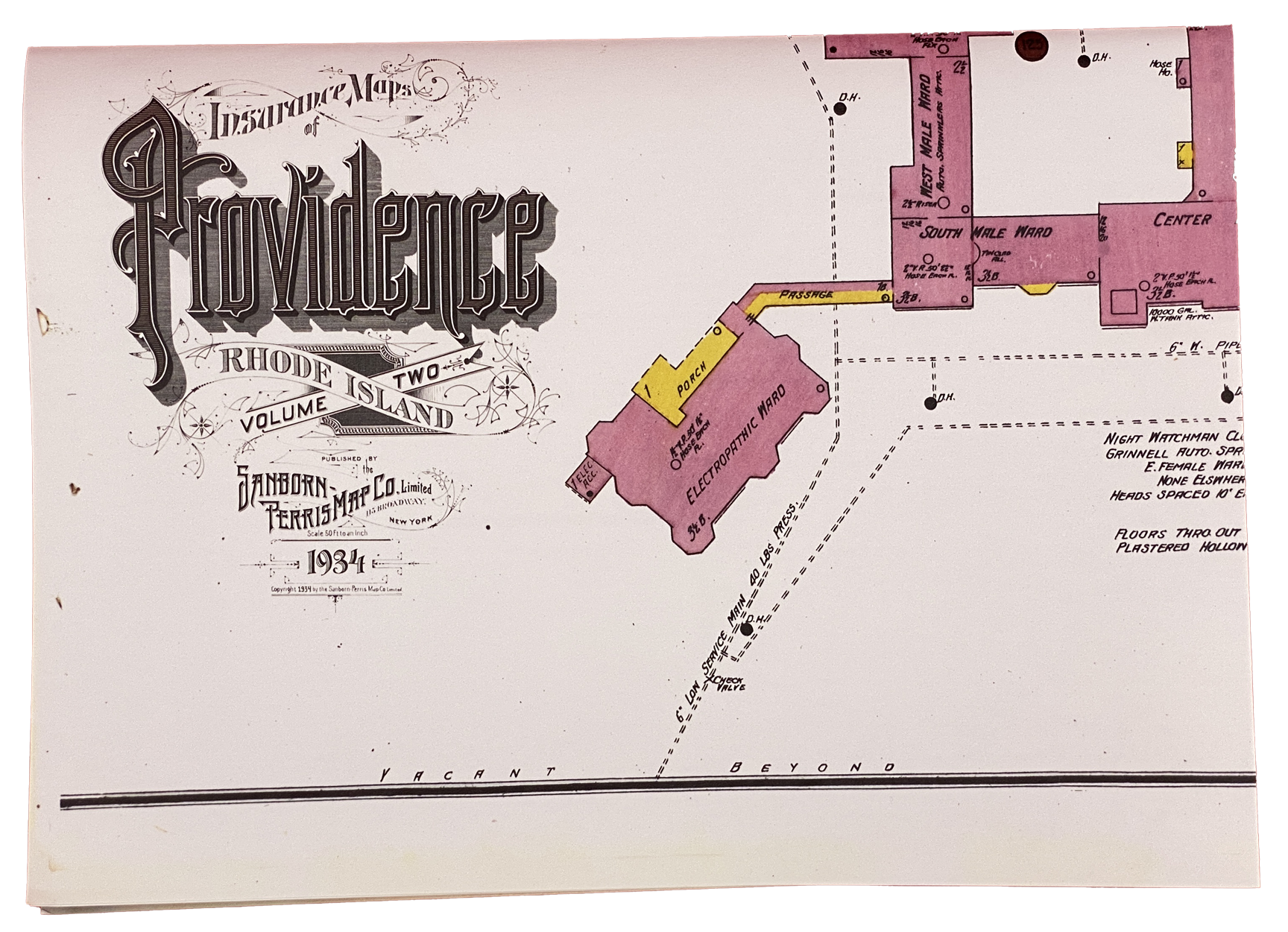 This large-format map is based on one of the extremely detailed fire insurance maps published by the Sanborn Insurance Company in 1921. The fictional Electropathic Ward has replaced what was really the Sawyer Ward.
This large-format map is based on one of the extremely detailed fire insurance maps published by the Sanborn Insurance Company in 1921. The fictional Electropathic Ward has replaced what was really the Sawyer Ward.
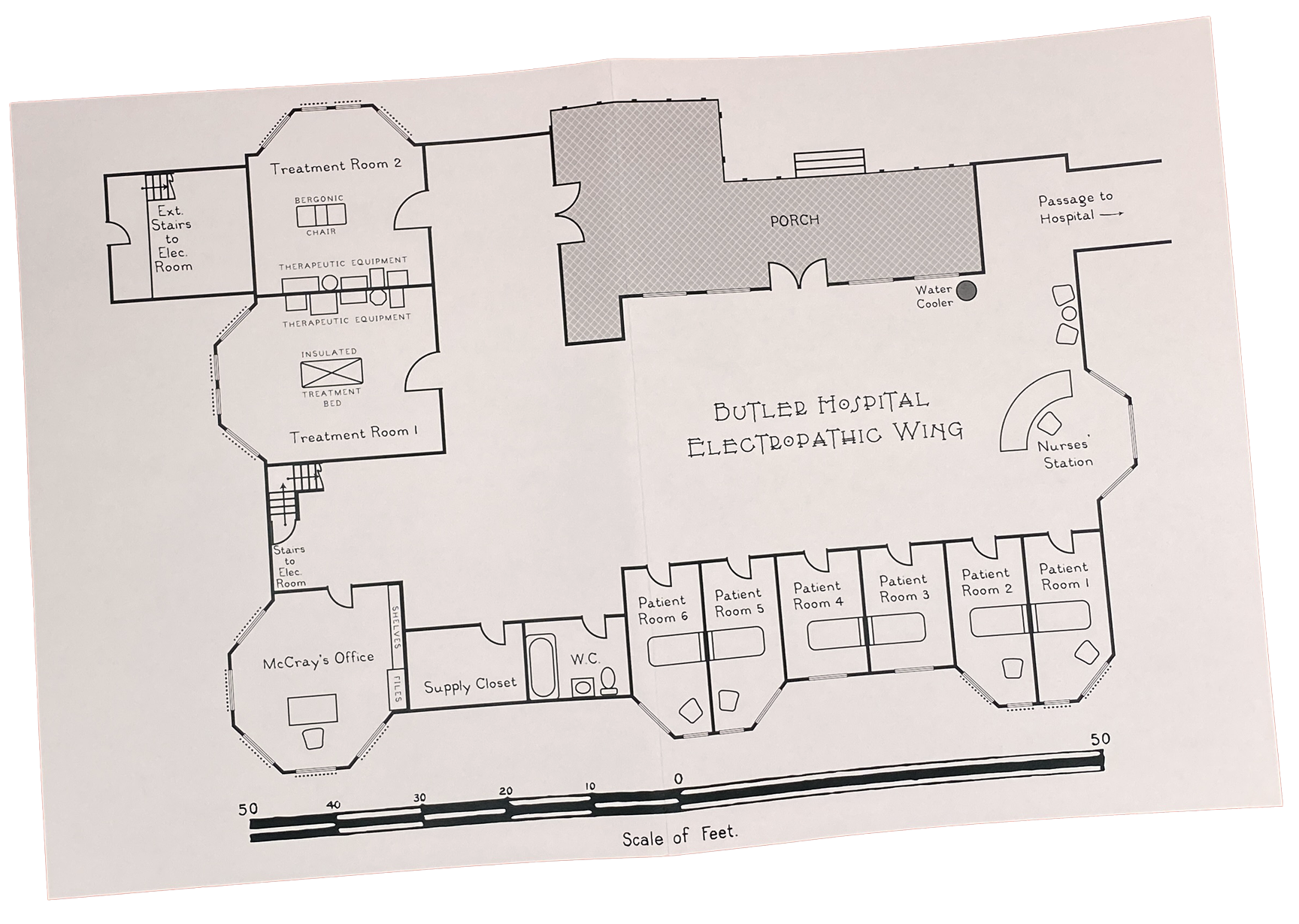 This handout is provided for gaming convenience, but it could be considered a prop if the Investigators were to find it in the Providence hall of records, or possibly in the possession of Joe Soletti from his days of working on the building. The floorplan shows the locations of McCray's office, patient rooms and nurses' station, as well as the various entrances and exits to the electropathic wing of Butler Hospital, including windows that are barred, and the direct route to the basement from the outside of the building. Anyone planning a surreptitious entry to the wing might find it very useful.
This handout is provided for gaming convenience, but it could be considered a prop if the Investigators were to find it in the Providence hall of records, or possibly in the possession of Joe Soletti from his days of working on the building. The floorplan shows the locations of McCray's office, patient rooms and nurses' station, as well as the various entrances and exits to the electropathic wing of Butler Hospital, including windows that are barred, and the direct route to the basement from the outside of the building. Anyone planning a surreptitious entry to the wing might find it very useful.
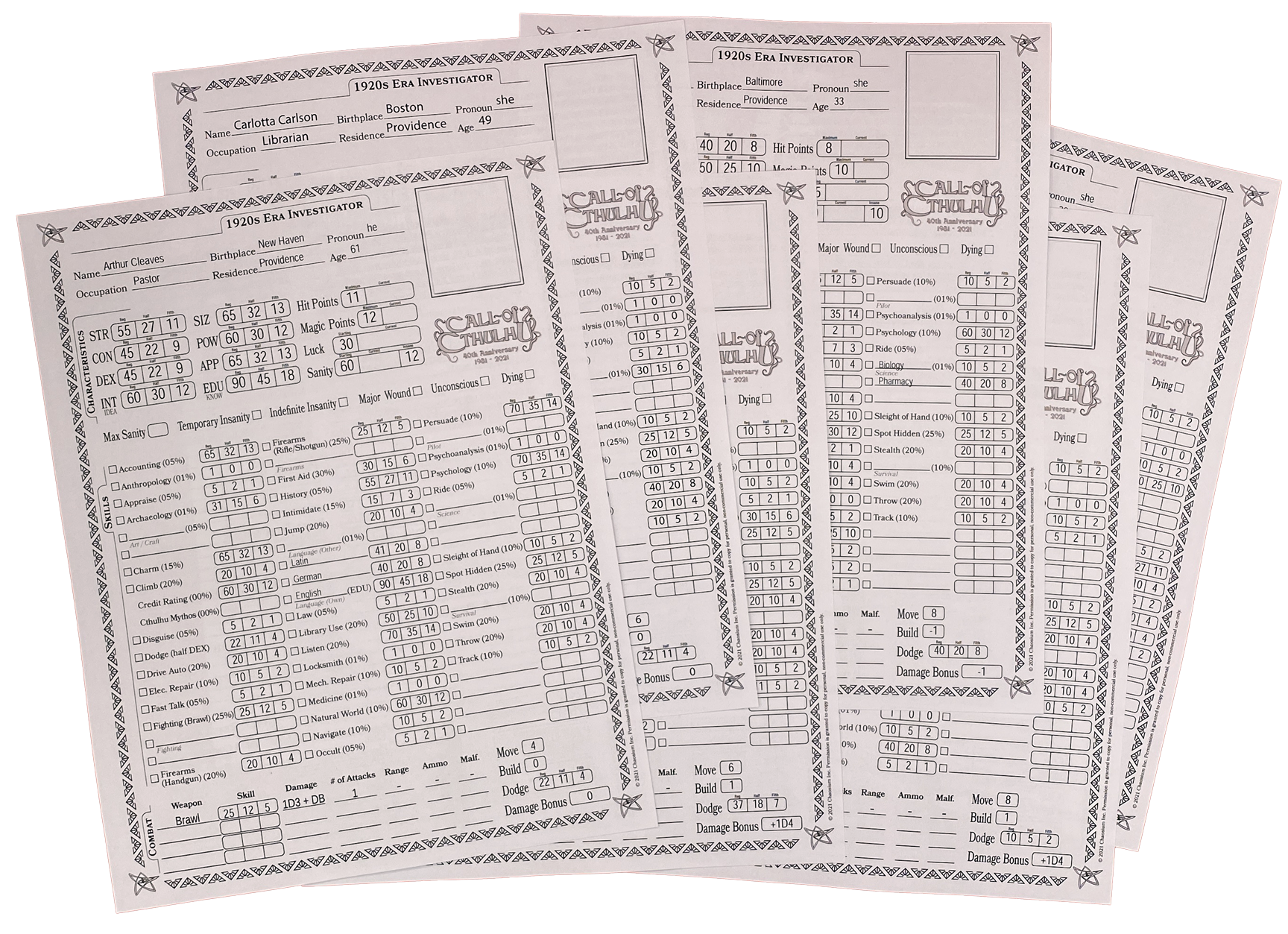 We have provided six pre-generated Investigator characters for use in the game. Your players can, of course, roll up their own characters, but investigative progress will be more difficult for characters who lack any skill in Electrical Repair or Library Use.
We have provided six pre-generated Investigator characters for use in the game. Your players can, of course, roll up their own characters, but investigative progress will be more difficult for characters who lack any skill in Electrical Repair or Library Use.
